They say a single picture can tell a story. But sometimes, knowing what’s behind the picture tells an even bigger one.
That’s exactly what History Cool Kids on Instagram does best—digging up incredible photos from the past and revealing the moments that made them iconic. Some will make you laugh, others might teach you something new, and a few will hit surprisingly deep.
Scroll down to see their most memorable posts and and upvote the ones that left a mark on you.
#1
Jewish prisoners after being liberated from a train that was intended to reach another concentration camp deeper within German territory, Friday, April 13th, 1945.
These are the words of Sgt. George C. Gross who was there that day.
“The major led our two tanks, each carrying several infantrymen from the 30th Infantry Division on its deck, down a narrow road until we came to a valley with a small train station at its head and a motley assemblage of passenger compartment cars and boxcars pulled onto a siding. There was a mass of people sitting or lying listlessly about, unaware as yet of our presence. There must have been guards, but they evidently ran away before or as we arrived, for I remember no firefight. Our taking of the train, therefore, was no great heroic action but a small police operation. The heroism that day was all with the prisoners on the train.
Major Benjamin took a powerful picture just as a few of the people became aware that they had been rescued. It shows people in the background still lying about trying to soak up a bit of energy from the sun, while in the foreground a woman has her arms flung wide and a great look of surprise and joy on her face as she rushes toward us. In a moment, that woman found a pack left by a fleeing German soldier, rummaged through it, and held up triumphantly a tin of rations…”
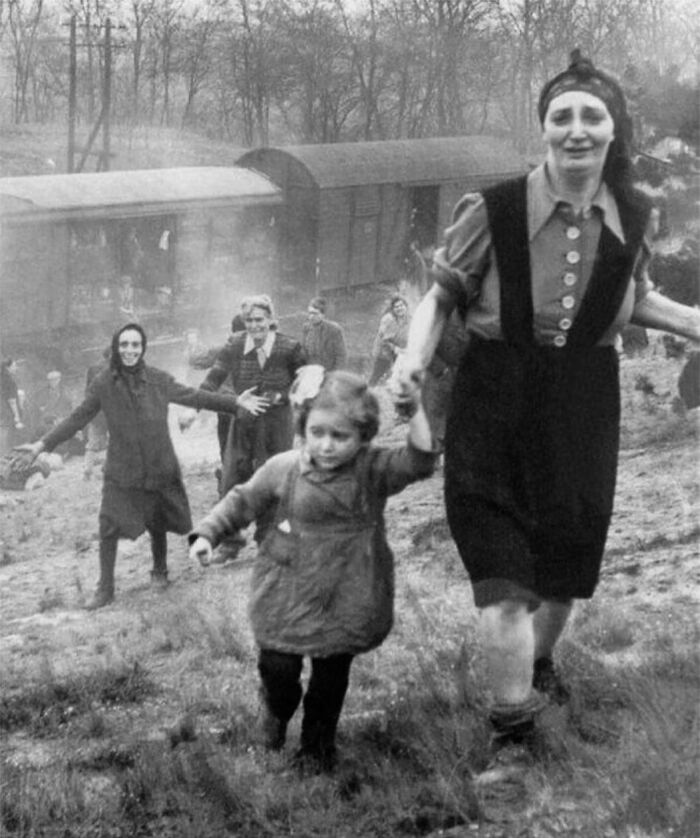
Image source: historycoolkids
#2
In 1963, Franca Viola was kidnapped and assaulted by a former suitor who, according to the custom of a so-called “rehabilitating marriage,” expected to marry her to erase the dishonor and avoid prosecution.
Instead of submitting to this deeply rooted practice, Franca and her father refused to be silenced or shamed. Their decision to press charges challenged a tradition that had forced countless women into marriages with their attackers. Her courage, and her family’s unwavering support, sparked national debate and helped pave the way for the abolition of the law (in 1981) that allowed perpetrators to escape punishment through marriage.
In 1966, her attacker was sentenced and imprisoned for 10 years. He was released in 1976, after which he remained barred from returning to Sicily. In April 1978, he met his demise in a Mafia-style execution near Modena, before he could return home.
As for Franca, she went on to build the life she chose for herself. In 1968, she married her childhood sweetheart, a man who stood by her through the ordeal. Their wedding drew national attention and was seen as a triumph of dignity over a cruel custom. Franca and her husband had three children and built a quiet family life in Alcamo, Sicily, where she still lives today.
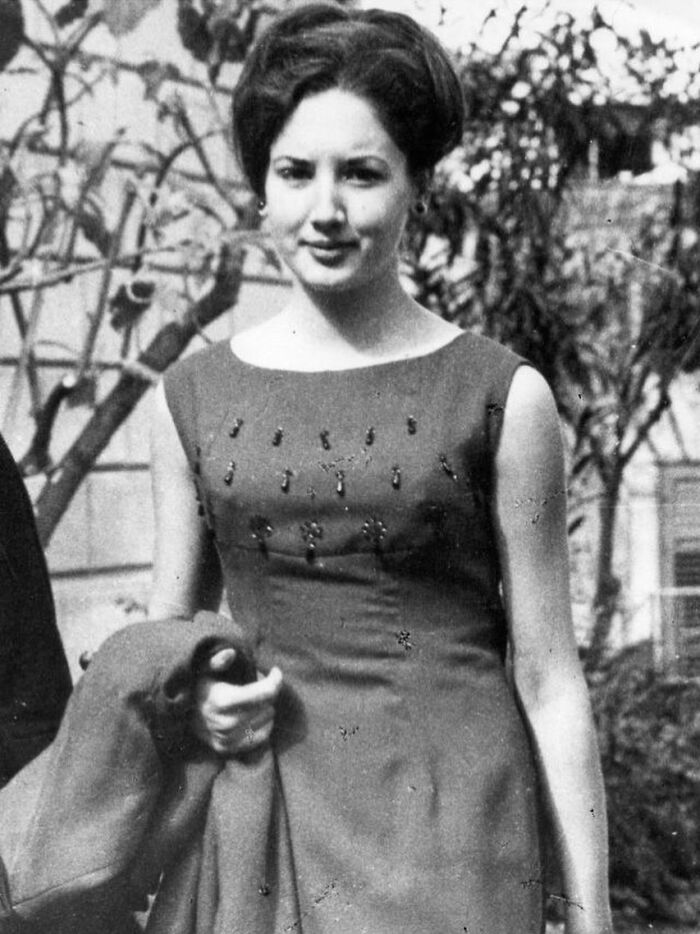
Image source: historycoolkids
#3
Wedding rings taken from prisoners at the Buchenwald concentration camp in Germany, May, 1945.
Shortly after the camp’s liberation, General George S Patton forced 1,000 local citizens to tour the camp to witness firsthand the atrocities that had taken place.
In response to the horrors discovered at the Ohrdruf concentration camp, General Dwight D. Eisenhower ordered U.S. troops to visit the camps, stating, “We are told that the American soldier does not know what he is fighting for. Now, at least, he will know what he is fighting against.”
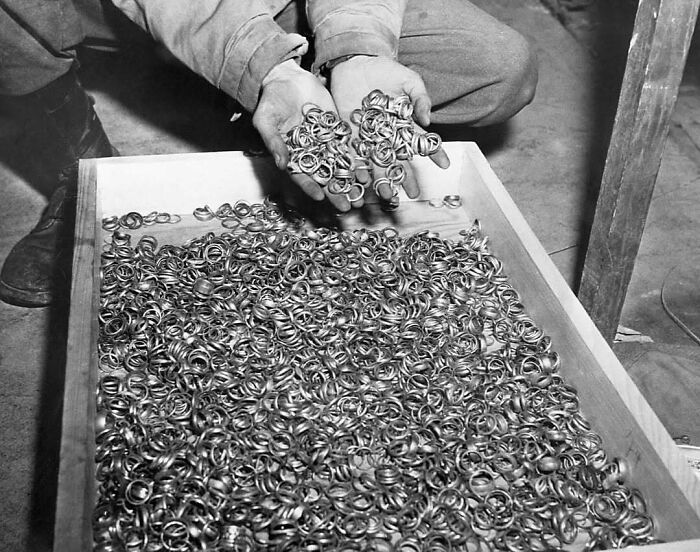
Image source: historycoolkids
#4
2,400 year-old skeleton mosaic discovered in Turkey with the caption: “Be cheerful, enjoy your life”
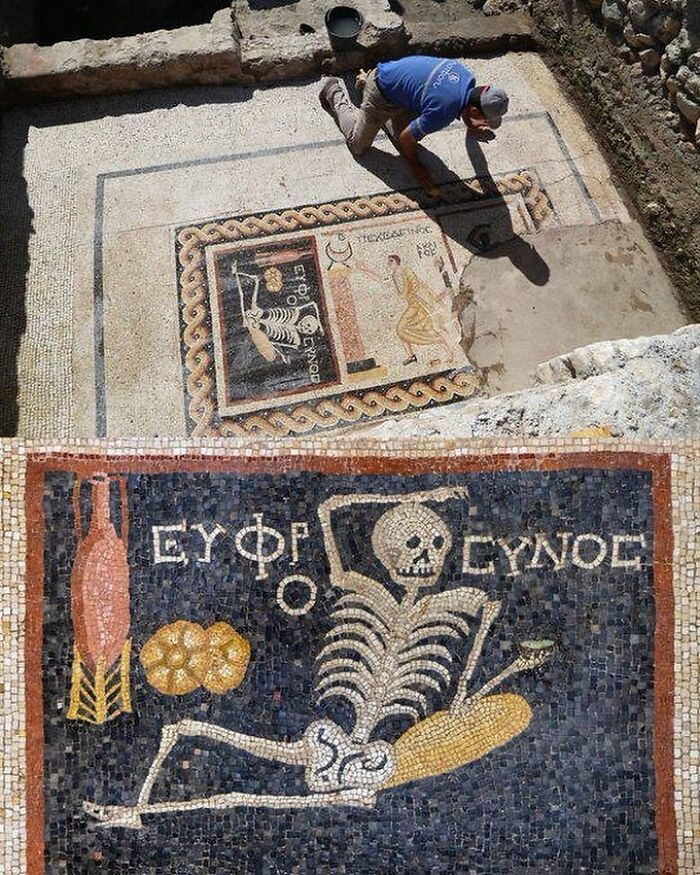
Image source: historycoolkids
#5
The “snow” in the Wizard of Oz movie was 100% pure asbestos.
Not only that, the Scarecrow stuffed his outfit with asbestos to prevent it from catching on fire.
The original Tin Man had his face painted with pure aluminum dust, which led to respiratory problems that sent him to the hospital. The film producer decided to replace him with actor Jack Haley. However, Haley was not immune to the toxic makeup, which caused an eye infection and made him miss four days of filming.
Margaret Hamilton as the Wicked Witch of the West also put on extremely toxic makeup that contained high levels of copper. Her makeup artist, Jack Young, once said, “Green is toxic because it’s made with copper. Every night when I was taking off the Witch’s makeup, I would make sure that her face was thoroughly clean. Spotlessly clean. Because you don’t take chances with green.”
Once she put on her makeup, Hamilton was forced to stick to a strict liquid-only diet to prevent her from ingesting any of the toxic paint.
Judy Garland was only 16 years old when she started filming the Wizard of Oz. On set, she was shunned by the Scarecrow, Tinman and the Cowardly Lion due to jealousy. Her only friend was Margaret Hamilton.

Image source: historycoolkids
#6
A Filipino survivor of the Battle of Manila shows the scar where a Japanese officer tried to behead him, 1945.
During the final months of World War II, the Battle of Manila turned into one of the most brutal urban battles in the Pacific Theater. Between February and March 1945, as American and Filipino forces closed in to retake the city from the Japanese Imperial Army, retreating Japanese troops and marines, rather than surrendering, carried out systematic executions of civilians. Photographs and accounts from survivors often show people revealing deep scars from bayonet wounds, saber cuts, or failed executions.
It’s estimated that over 100,000 civilians perished in Manila during this month-long carnage. The memory of these crimes remains a painful chapter in Philippine history that is largely unknown and forgotten in the West.
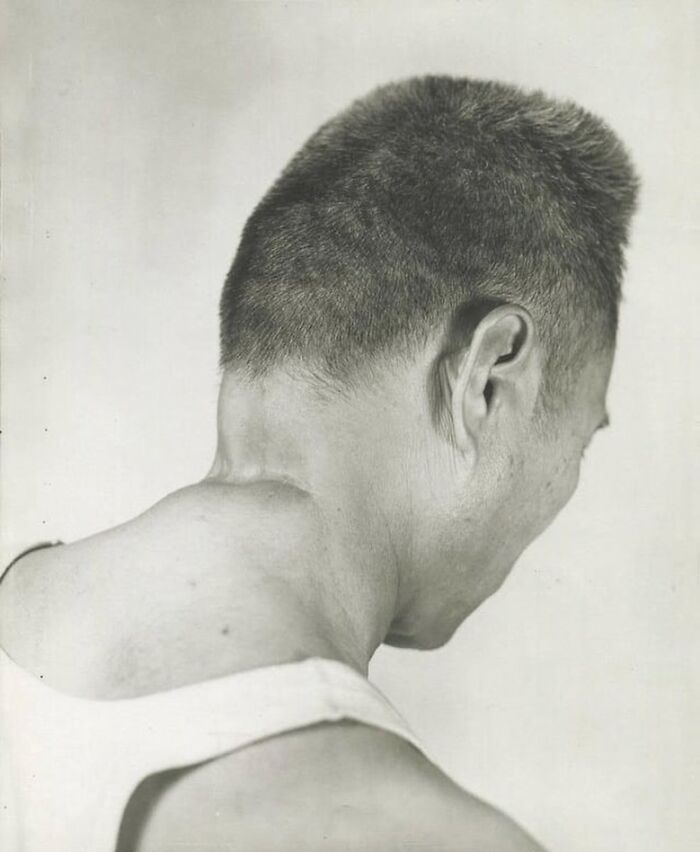
Image source: historycoolkids
#7
A girl in a pink coat seated alone in a graffiti covered subway car, 1986. Photographed by Camilo J. Vergara.
I remember taking the subways by myself when I was 8-years-old in the mid 90s. And yes, I still saw graffiti everywhere, but it was normal. That’s just how it was and I didn’t think much of it.
Most of the time, I roamed around with other kids, but safety was the last thing on our minds. We just wanted to get out of our tiny little apartments—especially during the hot, humid summers when school was out. We’d find refuge in the local public library (which always had the AC blasting) or just cool off in the streets when someone cranked open a hydrant with a heavy wrench. There was always music thumping from giant speakers and someone grilling up burgers and hot dogs.
NYC back then was grittier for sure, but there was more sense of community in the neighborhoods, at least in Brooklyn. We were all pretty poor, but everyone sort of watched out for each other. I know I sound like an old head when I start reminiscing about my childhood, but I do miss it from time to time. I don’t really recognize NYC anymore, but what can you do.
Things will always change…

Image source: historycoolkids
#8
Mugshot of John Wojtowicz who unsuccessfully tried to rob a bank in 1972 to pay for his wife Eden’s gender reassignment surgery.
Apparently, Wojtowicz had based his plans on the movie, “The Godfather” (1972) which he had watched earlier that day. His robbery attempt failed and he was arrested and sentenced to 20 years in prison of which he served five.
His story was later turned into a movie called “Dog Day Afternoon” (1975) starring Al Pacino and John Cazale, both of whom, interestingly enough, had starred in “The Godfather”.
For the rights to his story, Wojtowicz was paid $7,500 and 1% of the movie’s net profits, which he gave to Eden. After her operation, she married someone else before succumbing to pneumonia in 1987. Wojtowicz attended her funeral and delivered a eulogy.

Image source: historycoolkids
#9
2,000 year old giant cat geoglyph discovered in Peru’s famous Nazca Lines, a place recognized as a UNESCO World Heritage Site.
Experts believe it dates back to the late Paracas period, which is slightly older than most of the other Nazca Lines that fill the arid plain below. Unlike many of the more famous geoglyphs that are etched on the flat desert floor, this one was carved into a steep slope and had faded so much over time that it was nearly invisible until archaeologists spotted it while doing maintenance work.
The Nazca Lines include hundreds of massive drawings of animals, plants, and geometric shapes made by removing dark stones to reveal the lighter ground beneath. They have survived for centuries because the dry windless climate keeps them undisturbed.
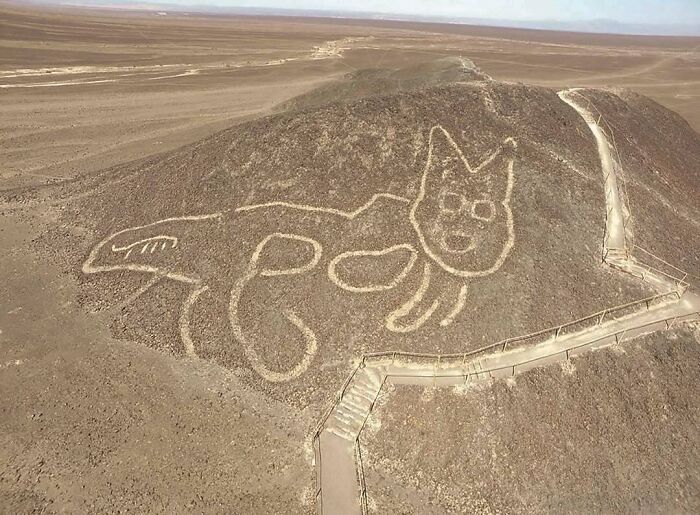
Image source: historycoolkids
#10
Kickin Jeans, also known as Action Jeans, were popular from 1977 to 1991. They looked like classic western jeans but featured stretch denim that let you move like a stuntman.
Not sure why it stopped being popular after 1991. Maybe that’s when everyone stopped kung fu fighting. I would grab a pair just for the “exclusive gusset in the crotch”.

Image source: historycoolkids
#11
Three well dressed women of Marshall, Texas, USA. 1899.
I can’t image how hot they must have been wearing these dresses in the ungodly Texas heat. I figured the temperature might have been cooler back then than it is now.
Interestingly enough, when I looked into the highest temperature ever recorded in Marshall, Texas, it was 112 °F (44.4°C) which occurred on August 18, 1909. I then looked at the lowest temperature ever recorded in Marshall, Texas and it was -13 °F (-25°C) which occurred on February 16, 2021.
Anyway, I know more than a 125 years have passed, but I just wanted to say that I love their fit check and that they all look lovely. Considering the year, I hope these ladies went on to live long fulfilling lives.
That smirking kid in the back does make me a bit nervous…as if he’s up to no good.
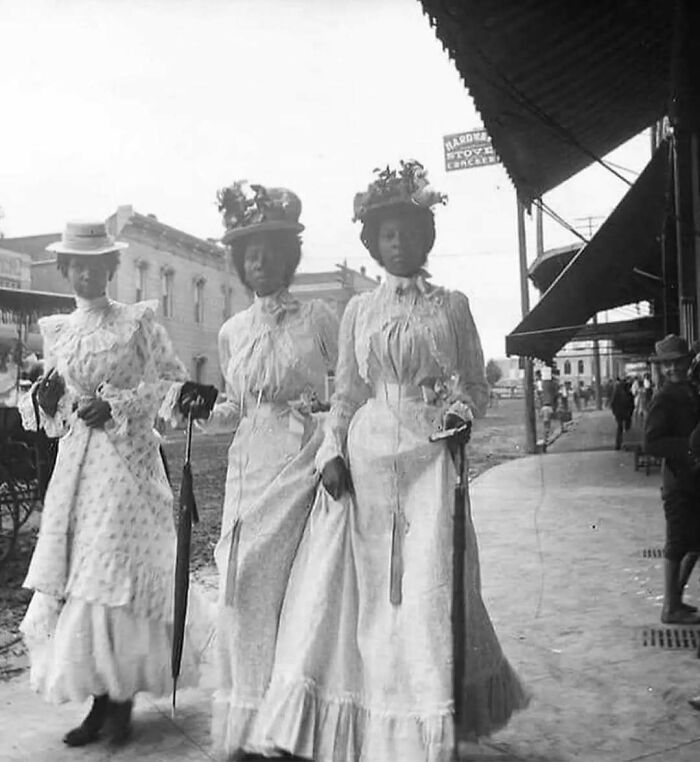
Image source: historycoolkids
#12
Being ticketed for indecent exposure at Rockaway Beach (New York City), 1946.
In my humble opinion, the bathing suit looks very decent and her hairdo looks fabulous. I also like her scowl.
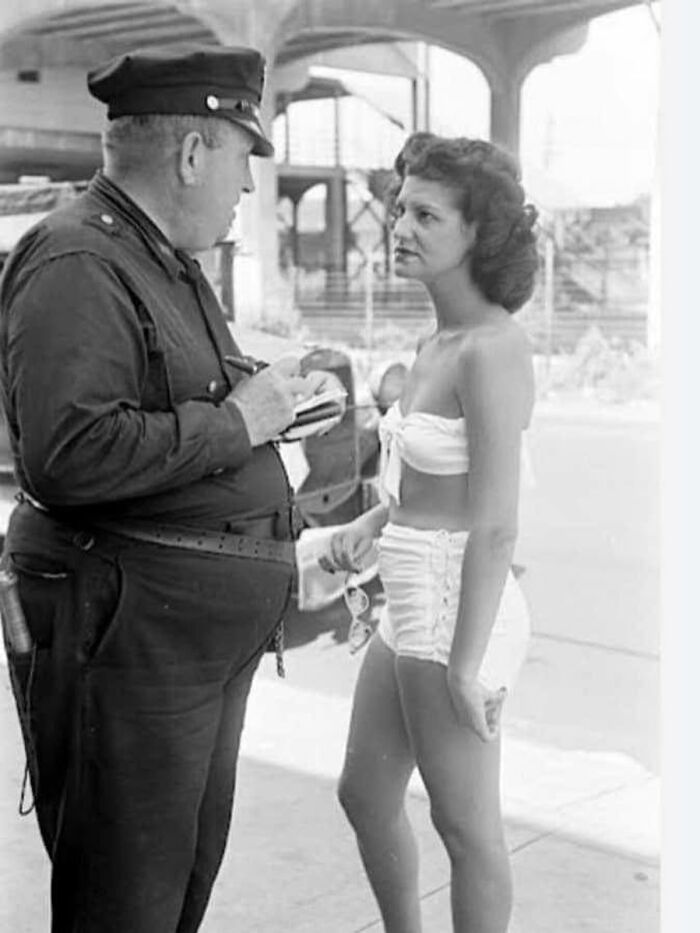
Image source: historycoolkids
#13
Mississippi’s first interracial bride and groom, Berta and Roger Mills, enjoying their wedding cake in 1970.
“Roger and Berta Mills, newlyweds, live in a modest apartment, but only a few close friends know its location. They avoid grocery shopping at peak hours. ‘We don’t want to advertise,’ Mills explains. They have no home phone and their mailing address is the law office where Mills works as a clerk. ‘We are trying to remain anonymous to avoid as much hate mail or calls as we can,’ Mills said.
Despite the problems, Mills, who is white, describes his 11-week marriage to Berta Linson, a black, as ‘a very, very pleasant experience.’ ‘It’s been real smooth. I feel like I’m still on my honeymoon.’
Roger and Berta get together socially with four other interracial couples living here, all of whom were married in other states. ‘The whites I know in Jackson are attorneys and some wealthy people,’ Mills said. ‘It would be a step down for them to visit us where we are.’ Despite the problems, Mills said, he regards Mississippi as a ‘pretty good state.’ ‘Things are progressing. I kind of like Jackson and the state but Berta is fed up with the tension.’
He said she is looking forward to moving to Washington next year when he returns to law school at George Washington University… Although the U.S. Supreme Court long ago ruled that no state could prohibit interracial marriages, there was a law in Mississippi banning such unions. It was only after the couple experienced considerable publicity and secured a federal court order that the marriage took place in Jackson’s Central United Church.
‘Berta hated every minute of it and it caused her a great deal of anguish,’ said Mills. Publicity followed them all the way to Gatlinburg, Tenn., where they honeymooned at the foot of the Smoky Mountains. ‘Everywhere we stopped we saw newspapers carrying stories of the marriage,’ Mills said.”
Source: The Cincinnati Enquirer on November 26, 1970

Image source: historycoolkids
#14
The B-2 Spirit vs. the peregrine falcon.
The plane’s sleek, aerodynamic shape and stealth capabilities were heavily inspired by the bird’s natural form and hunting techniques. Specifically, the B-2’s “flying wing” design, which reduces air resistance and increases fuel range, is reminiscent of the falcon’s streamlined body and efficient flight. Furthermore, the B-2’s ability to absorb radar waves and minimize heat and noise is comparable to how a falcon’s feathers can absorb sound and how its body hides heat and noise during a dive.
Conceived in the late 1970s, the B-2 was first unveiled to the public in 1988 and took its first flight in 1989. With a unit cost exceeding $2 billion, the B-2 became one of the most expensive aircraft ever built. A total of 21 were built and currently there are 19 in operation.

Image source: historycoolkids
#15
A pair of hammerhead sharks depicted in the “Oki National Products Illustration Notes” during the Edo Period in Japan, 1735.
I love how this illustration appears to be remarkably modern and cartoon-like, despite it being nearly 300 years old. I guess the Japanese always had a knack for drawing cute animals even way back then…
One cool fact about hammerhead sharks is that no fatal attacks against humans have ever been recorded. They also travel in large groups of up to 500 sharks, usually in the summer months as they migrate to find cooler waters. As for its weird head shape, the hammerhead has evolved to be better at sensing its environment, however the drawback is that they are equipped with smaller mouths, making them less effective at killing their prey.

Image source: historycoolkids
#16
Krystyna Trześniewska was a young Polish girl whose life was cut short at Auschwitz.
Born on December 8, 1929, in Majdan near Zamość, she was only 13 when she and her father Julian were taken during the “Zamość Action,” a campaign to remove Polish villagers and make room for German settlers.
Deported on December 13, 1942, she was registered as prisoner number 27129. Her photograph has become a powerful reminder of the thousands of Polish children swept into the horrors of Auschwitz. Krystyna’s life ended on May 18, 1943, only a few months after her arrival.
Polish prisoners were among the first and largest groups held at Auschwitz. When the camp opened in 1940, it mainly held Polish political prisoners—teachers, priests, resistance members, and anyone seen as a threat to German rule. Many were arrested during mass round-ups or village expulsions. Brutal conditions, forced labor, starvation, and executions were common.
While Jewish people later became the largest group deported to Auschwitz, around 150,000 non-Jewish Poles were imprisoned there, and many never returned. Their suffering shows how the camp was part of a broader plan to destroy Polish society and leadership.
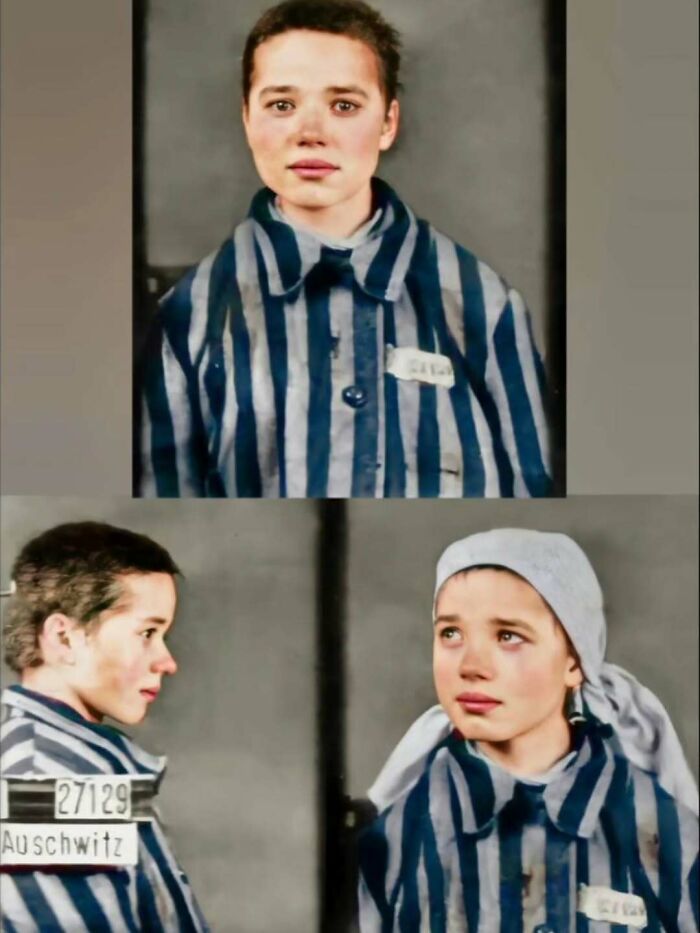
Image source: historycoolkids
#17
An Auschwitz survivor holds her great-granddaughter.
To be honest, I felt really uneasy being able to use the number (49398) tattooed on her arm to look her up, but I wanted to know her story.
Her name was Marie Soifer and she was born in Paris, France on September 9, 1915. She was 28-years-old when she was sent to Auschwitz. She spent close to 16 months there before being liberated on January 27, 1945.

Image source: historycoolkids
#18
Just a man delivering a birthday cake on a bicycle in Cuba, 1997.
I hope he didn’t drop it. You can tell that he is stressed!

Image source: historycoolkids
#19
Charles the II of Spain was the result of nearly 200 years of inbreeding. The House of Habsburgs stopped introducing new genes at around 1550, leading to a circular family tree.
Charles the II had been born the son of an uncle-niece relationship, and historians Will and Ariel Durant described him as “short, lame, epileptic, senile and completely bald before 35… baffling Christendom by continuing to live.”
Before the age of six, Charles the II had managed to survive an onslaught of diseases which included chickenpox, measles, rubella, and smallpox. He could not walk until he was 8-years-old and could not chew food on his own. His tongue was so large that no one could understand what he was saying.
The nuncio papal Millini provided the following description of Charles the II: “The king is rather short, skinny, but not badly formed, only ugly in the face; he has a long neck, a long face, a long chin and as if it bent upwards; the lower lip typical of the Habsburgs; not very large eyes, turquoise blue and a fine and delicate complexion. He has a look with melancholy on his face and a little astonished. His hair is blond and long, and it is combed back so that the ears are exposed. He cannot straighten, unless he leans against a wall, a table or something else. His body is as weak as his mind. From time to time he shows signs of intelligence, memory and a certain liveliness, but not now; he usually looks slow and indifferent, appearing dumbfounded. You can do whatever you want with him, since he lacks of own will.”
Charles the II’s passing in 1700 (at the age of 39) led to the War of Spanish Succession and the dissolution of the The House of Habsburgs.
His autopsy report stated that his “heart was the size of a peppercorn; his lungs corroded; his intestines rotten and gangrenous; he had a single testicle, black as coal, and his head was full of water.”

Image source: historycoolkids
#20
A family living in a tree stump house, 22 feet (7m) in diameter, 1901.
In the early 20th century, some families lived in tree stump houses, making use of nature’s massive remains, especially in the American Pacific Northwest, where logging had left behind enormous old-growth stumps from ancient redwoods or Douglas firs.
Families who lived in stump houses often built floors, walls, and roofs within or over the stump cavity, adding windows and doors to let in light and air. Some stumps were even big enough to accommodate two or three stories, with ladders or stairs connecting levels.
These homes provided not only shelter but also an affordable solution for settlers and loggers who needed immediate housing while clearing and homesteading forested land. Life inside a stump house was simple but resourceful—a wood stove for cooking, bunks or lofts for sleeping, shelves carved into the walls for storing essentials.

Image source: historycoolkids
#21
Swim instructor at the YMCA, Toronto, 1908.
The stick is used to test the student. The instructor pushes them underwater, which naturally triggers panic. However, if the swimmer resists the urge to thrash around and struggle, they’ll naturally float back up on their back.
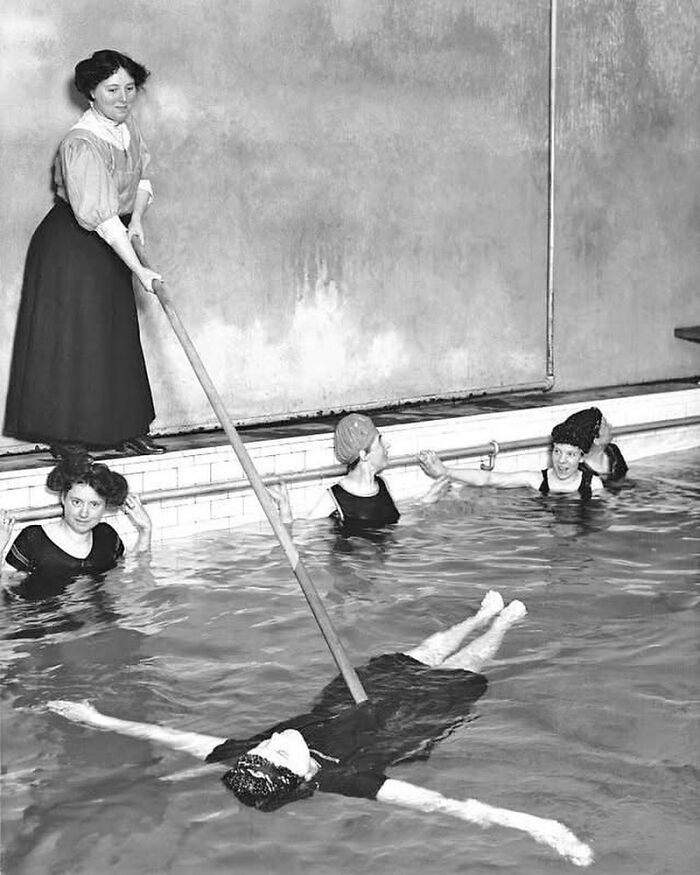
Image source: historycoolkids
#22
Japanese photographer Masahisa Fukase photographed his wife Yoko everyday for his photo series “From Window” in 1973.
Yoko left him after 10 years of marriage because according to her “…he would only look at me through the lens of a camera. The photos he took of me were undoubtedly depictions of himself.”
This sent Fukase into a deep spiraling depression and he would spend the next 6 years (1976 to 1982) photographing ravens in Hokkaido, Kanazawa, and Tokyo. His book Ravens, first published in 1986 is my personal favorite photo book of all time.
In 1976, when Fukase began capturing photos of ravens, he told Camera Mainichi magazine: “I’m wishing that I could stop this world. This act [of photography] may represent my own revenge play against life, and perhaps that is what I enjoy most.”
At the end of his project in 1982, Fukase simply wrote that he had “become a raven”.

Image source: historycoolkids
#23
Anne Frank was photographed with her sister Margot at the beach in Zandvoort in the Netherlands in 1940.
Margot was the older sister, quiet and serious, and while Anne’s diary became one of the most read accounts of the Holocaust, Margot also kept a diary of her own during their time in hiding. Sadly, no trace of Margot’s diary was ever found after the war.
Margot, like Anne, was deported after the family’s hiding place was discovered in 1944. The sisters were eventually sent to the Bergen Belsen concentration camp, where they both perished of illness and starvation in early 1945, just weeks before the camp was liberated.
On April 5, 1944, Anne Frank wrote in her diary: “When I write I can shake off all my cares. My sorrow disappears, my spirits are revived! But, and that’s a big question, will I ever write be able to write something great, will I ever become a journalist or a writer?“
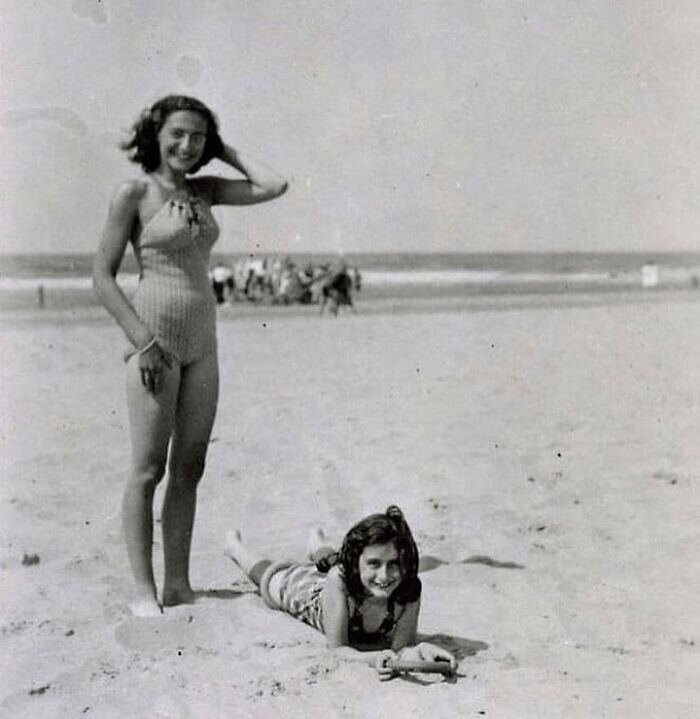
Image source: historycoolkids
#24
Published in The Baltimore Sun, Maryland, June 15, 1924.
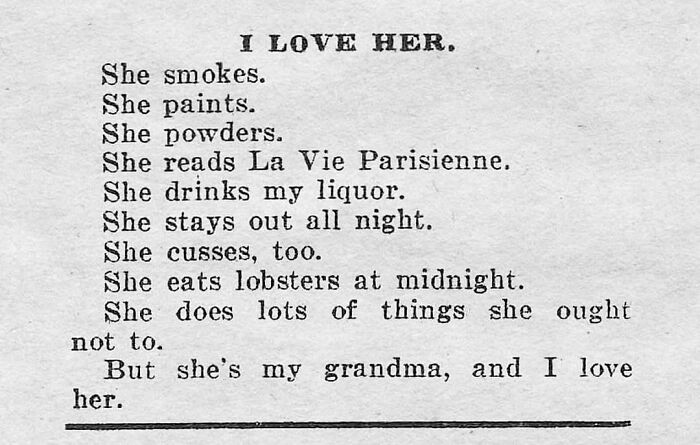
Image source: historycoolkids
#25
Office life before the invention of AutoCAD and other drafting softwares.
Prior to the release of AutoCAD in 1982, engineering drawings were all done by hand using different grade pencils, erasers, T-squares and set squares.
Even after all the manual labor, if a change was required, the engineers and toolmakers had to start from scratch and make the sketches all over again. Nowadays, architecture designers and other drafters are mainly just clicking their mouse and keyboard and not hunched over on a giant desk wondering if any changes will be made to their final drafts.

Image source: historycoolkids
#26
The crowning of the winner of Miss American Vampire, Palisades Amusement Park in New Jersey, September 1970.
Goth needs to make a comeback
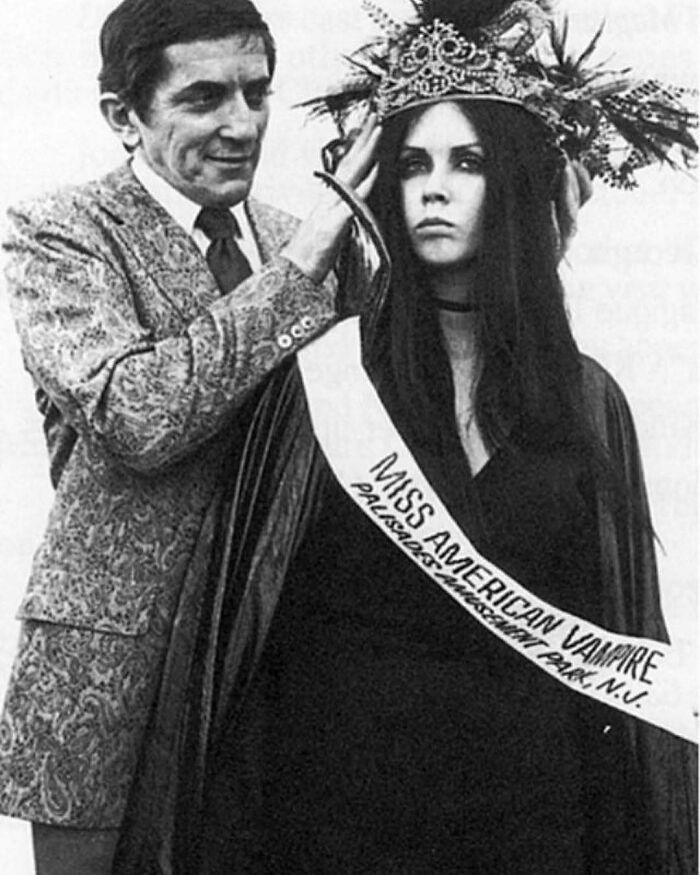
Image source: historycoolkids
#27
Mary Vincent’s story is one of astonishing endurance and unbreakable will.
In 1978, at just fifteen, she was attacked by a man who picked her up while she was hitchhiking in California. He brutally assaulted her, severed both her forearms with an axe, and hurled her down a ravine, assuming she wouldn’t survive.
But Mary refused to give up. She dragged herself back up the sheer embankment, packing her arm stumps with mud to stop the bleeding, and then walked for miles, unclothed and grievously wounded, until she found help from a passing couple.
Mary not only lived but testified against her attacker, ensuring he was imprisoned, not once, but twice! Later, she built a life for herself, raised a family, and became an advocate for victims’ rights, showing extraordinary resilience in the face of a crime that could have destroyed her.
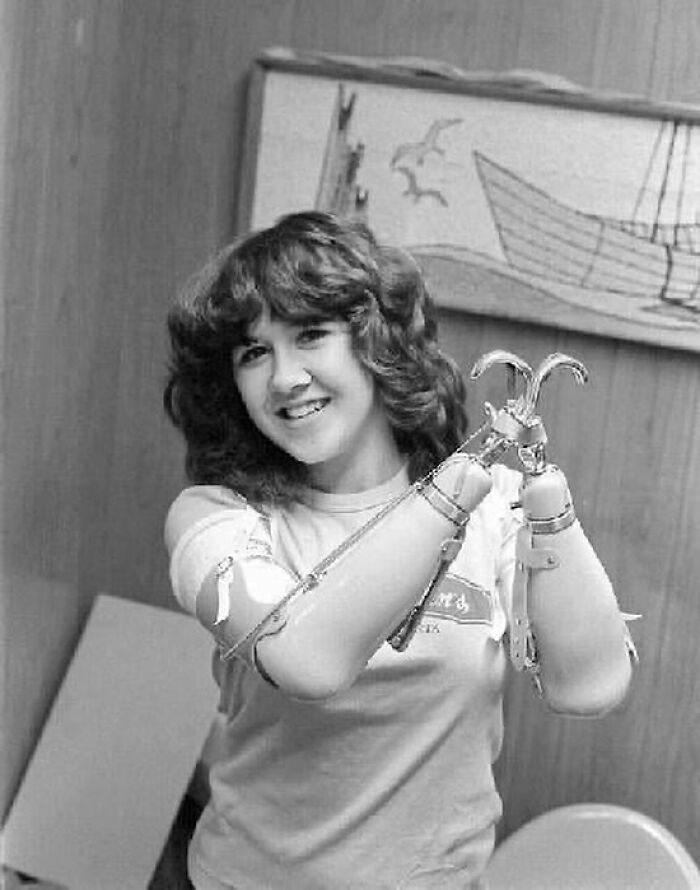
Image source: historycoolkids
#28
An Inuit otter amulet. Engraved and pigmented ivory, c.1870-1880.
“According to oral tradition, a man who was collecting shellfish was surprised by the in-rushing tide; to save himself he cried out, ‘I wish I might turn into a sea otter!’ His wish was granted, which is why, it is said, the internal organs of a man and a sea otter look the same. This ivory hunting charm was fastened inside the cockpit of a kayak. The otter’s ribs and spine are shown, perhaps because an otter’s soul was believed to reside in its skeleton. Its bones were returned to the sea so a new otter could be born.”
Source: https://www.si.edu/object/nmnhanthropology_8348741
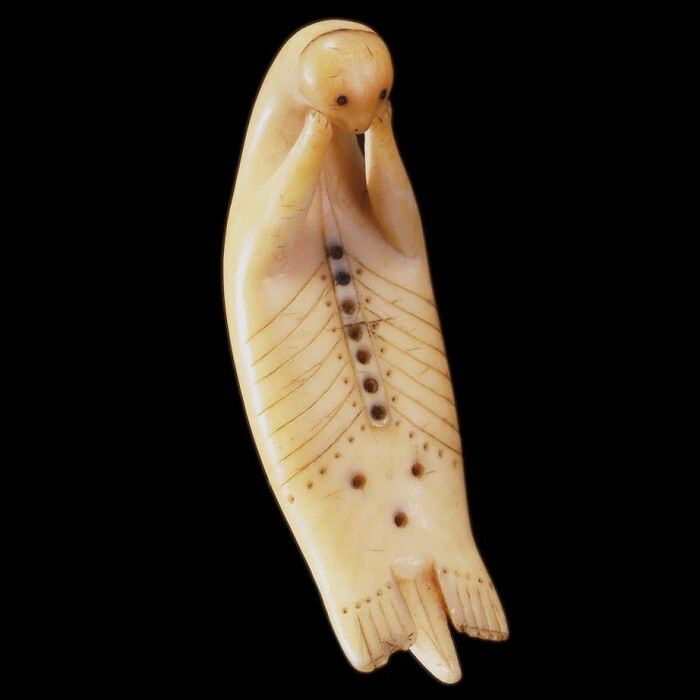
Image source: historycoolkids
#29
Gustav Klimt was only 17-years-old when he drew this Portrait of a Girl (1879).
He was still a young art student at the Vienna School of Arts and Crafts. This piece is a drawing done in pencil or chalk, showcasing Klimt’s remarkable draftsmanship before he developed the highly decorative, symbolist style he’s most famous for.
In this early period, Klimt’s work focused on precise, academic realism and portraiture, reflecting his classical training. The drawing likely depicts a young girl in a delicate, naturalistic pose, rendered with soft lines and subtle shading. Unlike his later golden, mosaic-like paintings, works like this show Klimt’s roots in traditional figure drawing and his keen observation of human expression and anatomy.
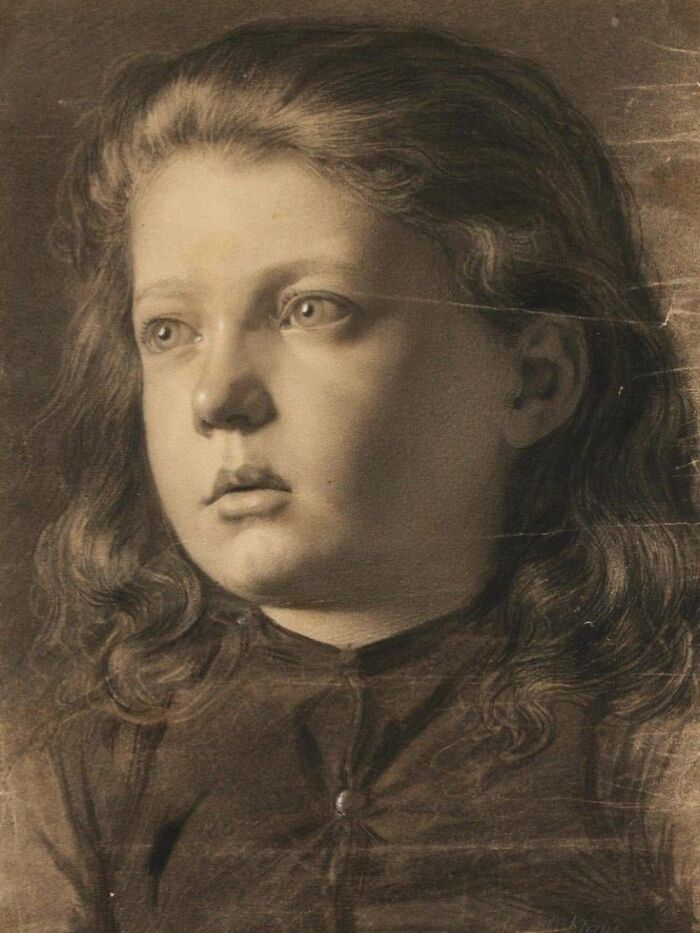
Image source: historycoolkids
#30
At first glance, I thought he could be a time traveler…
Those tinted glasses look too modern to be worn by anyone from the 1850s. His facial expression seems to convey a sort of coy playfulness as if he knows he belongs in the Matrix. The blurry cat only makes the portrait look more surreal.
But looks like there is an explanation for everything.
This is the caption provided the George Eastman Museum in Rochester, New York:
“Inscribed in pen on applied label on spine of case: 388 Entry 388 in Mackay’s notebook (located in library): Daguerreotype of young man, black hair, full beard, in vest & shirt & sleeves, holding cat which moved, making head disappear. Man has black glasses and probably blind. Very unusual. Attractive papier maché & pearl case. Case 1.25. Daguerreotype gift. Total 1.25. Unknown man.”
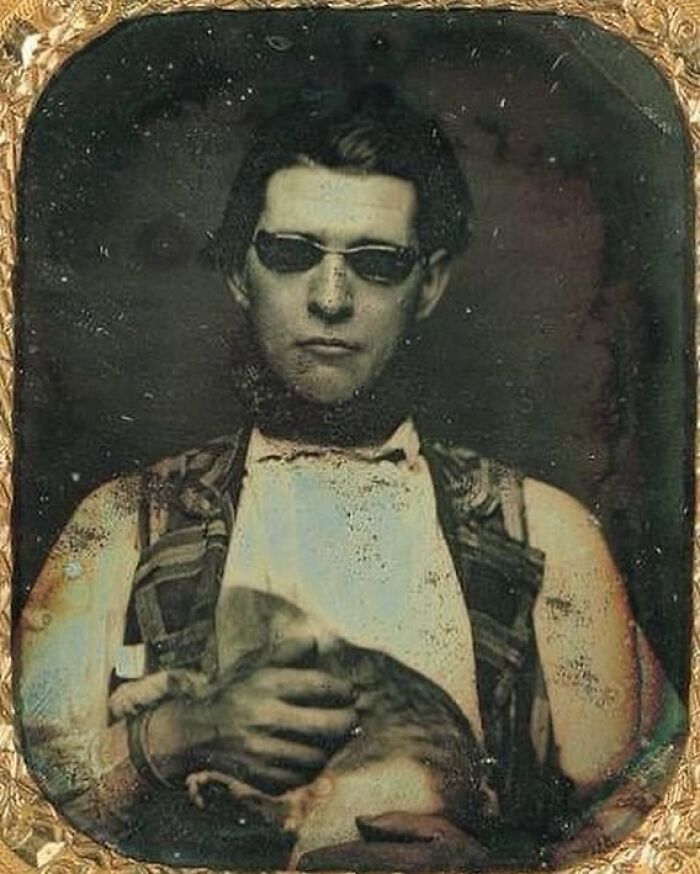
Image source: historycoolkids
#31
A road in Pompeii, built before the catastrophic eruption of Mount Vesuvius in AD 79, demonstrates the Romans’ practical ingenuity.
The small white stones you see embedded in the darker basalt paving stones were intentionally chosen and set into the road surface. Their purpose was to reflect the faint glow of moonlight, helping travelers and carts navigate more safely after dark.
This clever technique turned the road itself into a primitive form of “street lighting” long before lamps were common. It’s a subtle example of how Roman engineers considered not just durability and drainage in their roads, but also usability at night, a testament to the sophistication of everyday infrastructure in the ancient city.

Image source: historycoolkids
#32
David Vetter (aka “Bubble Boy”) was born in 1971 with severe combined immunodeficiency (SCID), a rare and life-threatening genetic disorder that left him without a functioning immune system.
Even the most ordinary germs could be fatal, so from infancy, he lived in a completely sterile, sealed environment designed to protect him from infection. The structure allowed for limited interaction with his family and doctors, but every object or person that came into contact with him had to go through extensive sterilization.
His condition gained national attention, symbolizing both the promise and the limitations of medical science in the 1970s and early 1980s. Despite the isolation, David showed remarkable intelligence, curiosity, and humor. He received his education through television and written materials passed into the bubble, and maintained relationships through a transparent barrier.
In 1983, at age 12, David underwent a bone marrow transplant from his sister in an experimental effort to give him a functioning immune system. Sadly, the transplant introduced an undetected Epstein-Barr virus, which led to cancer. David passed away a few months later from lymphoma, a complication of the virus.
Approximately $1.3 million was spent on his care.
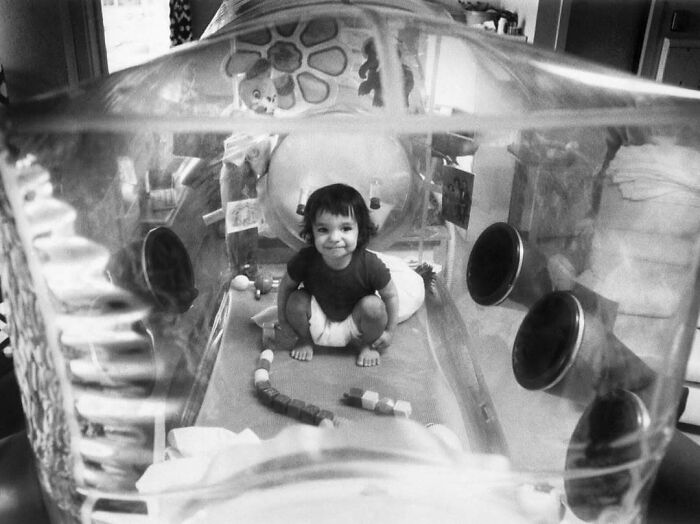
Image source: historycoolkids
#33
The Dutchiest father of all time, 1966.
He should invest in a bakfiets though—much safer way to transport two kids.
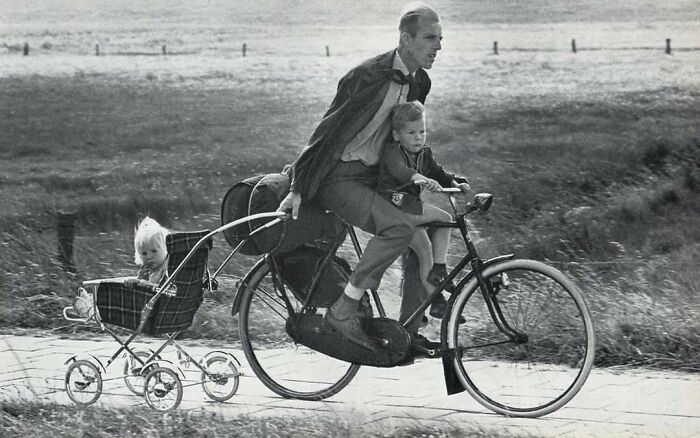
Image source: historycoolkids
#34
Woman carrying hay on her head in Cogne, Italy, 1959. Photo by Pepi Merisio.
I briefly worked on a farm for a summer when I was a college student and I learned that if farmers don’t properly dry the hay they’re baling, the hay bales can spontaneously combust and they’re really hard to put out because the fire comes from deep inside the bale.
I know everyone is concerned about this lady’s back and neck, but I’m hoping she never experienced spontaneously combustible hay while it was on top of her head.
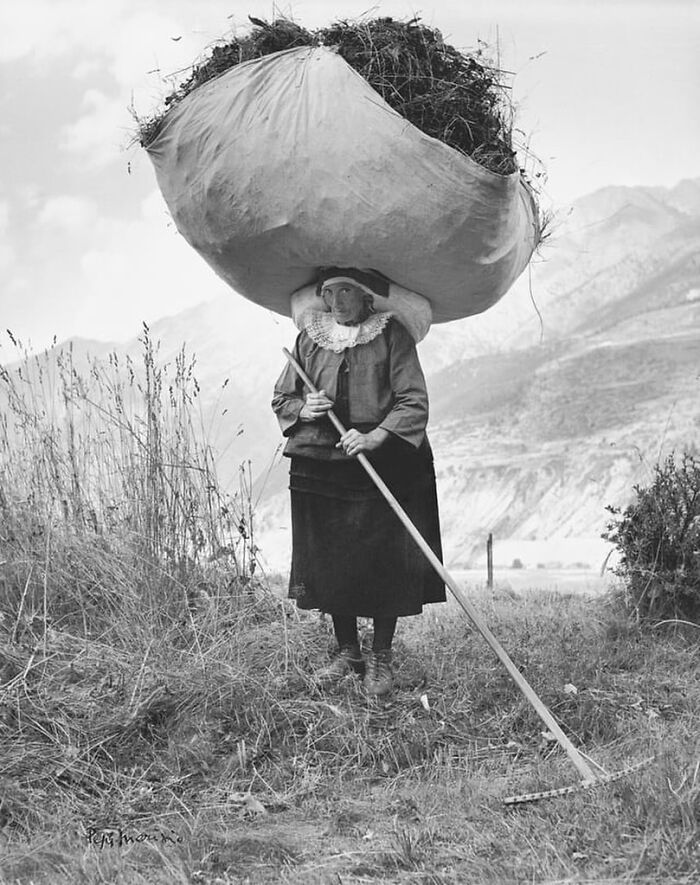
Image source: historycoolkids
#35
18,000-year-old puppy discovered in the Siberian permafrost near Yakutsk, Russia.
Nicknamed “Dogor” (a Yakut word meaning “friend” and also a play on “dog or…”), the specimen had intact fur, whiskers, nose, and even teeth. It was an exceptional find because soft tissues rarely survive so long.
Genetic testing revealed that the animal belonged to a period when dogs were first being domesticated from wolves, but its DNA didn’t clearly match either modern wolves or domestic dogs. This has led researchers to believe that Dogor might belong to an ancient population right at the evolutionary split between wolves and the first domesticated dogs or possibly an extinct lineage altogether…
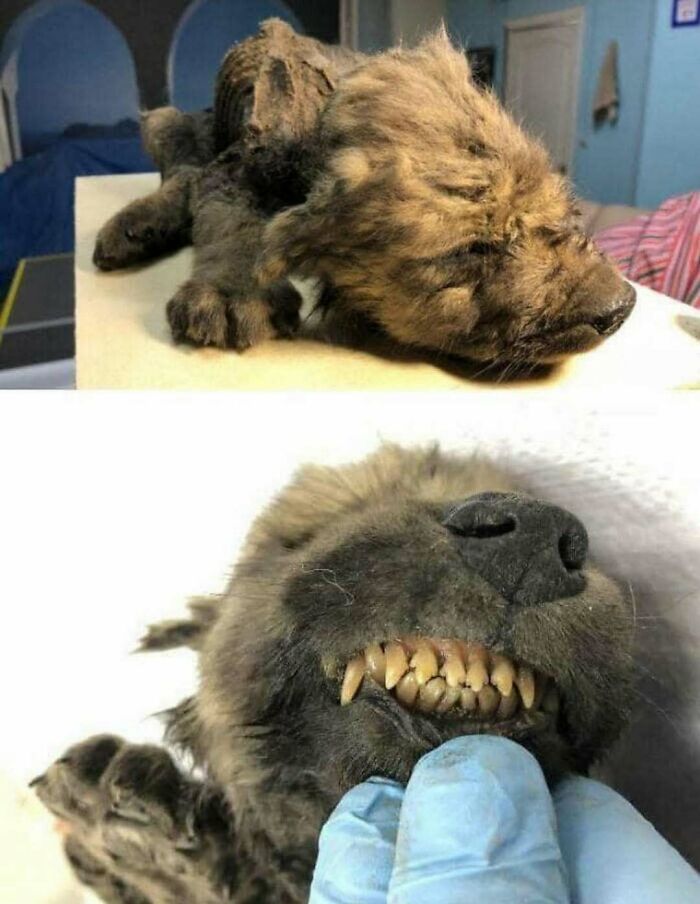
Image source: historycoolkids
#36
It should be noted that Kant did have a manservant by the name of Martin Lampe who was integral to Kant’s rigid daily schedule, helping to maintain the predictable, clockwork regularity that Kant believed was essential to his work and well-being. Lampe would wake Kant at the same time every day, prepare his meals, and manage his household affairs, freeing Kant to focus on his writing and teaching.
Lampe also faithfully read all of Kant’s work. However, when Kant published, “The Critique of Pure Reason” in 1781, he began to read it, but gave up halfway through, saying he’d end up in an asylum if he continued.

Image source: historycoolkids
#37
After being abandoned during the 1996 Everest disaster (once by his team and again later by rescuers who assumed he would not recover) Seaborn Beck Weathers somehow regained consciousness in the freezing dark and walked, frostbitten and nearly blind, back into camp. His return stunned everyone.
Despite the massive toll the experience took on his body, including the loss of his nose, right hand, and parts of his left fingers, he went on to continue a successful career as a pathologist. He also became a motivational speaker and has appeared on crime and medical shows, often offering insight drawn from both his profession and his personal experience.
The helicopter rescue that finally brought Beck off the mountain has become legend. Nepalese pilot Lt Col Madan Khatri Chhetri pulled off a nearly impossible feat. He flew a chopper far above its rated ceiling, where the thin air made lift almost nonexistent. With no space to gain speed, he launched the helicopter by dropping off a ledge, letting gravity carry them downward until the blades could catch enough air to keep them stable.

Image source: historycoolkids
#38
The very final form of design.
Any other products that are just perfect, the way they are?

Image source: historycoolkids
#39
The man on the left is Danish astronomer Tycho Brahe (1546-1601).
The fake nose (made of bronze) on the right is what he wore after he lost his real nose in a sword duel with his cousin Manderup Parsberg.
They had gotten into a drunken quarrel over who was the better mathematician.
On special occasions, Brahe would swap out the bronze nose for a silver or gold one.
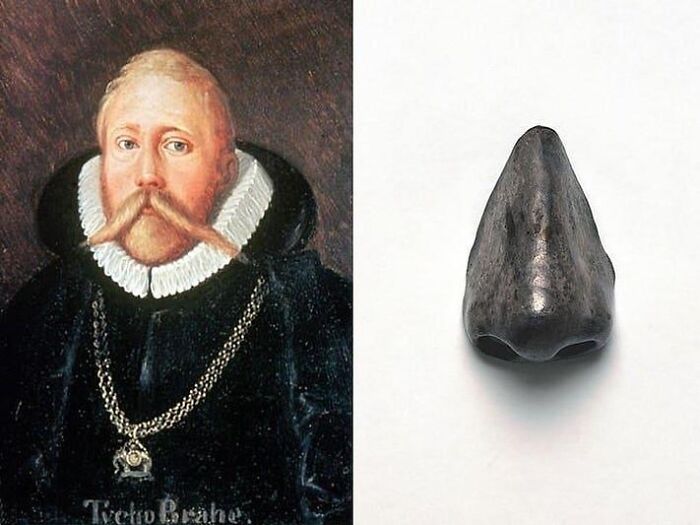
Image source: historycoolkids
#40
The Sausage Queen of Zion, Illinois, 1955.
While specific details about this exact title and event are scarce in official records, it’s likely that the “Sausage Queen” was part of a local meatpacking or food festival promotion, perhaps tied to a butcher shop, sausage company, or regional celebration in Zion, a town known for its tight-knit community and conservative roots.
In the 1950s, titles like “Sausage Queen,” “Corn Princess,” or “Apple Blossom Queen” were common marketing tools used to draw crowds, generate publicity, and give a playful spotlight to local women in community parades or county fairs. Such events were often photographed and distributed to regional newspapers, serving as light news and cultural snapshots of the postwar era’s optimism and love of spectacle.
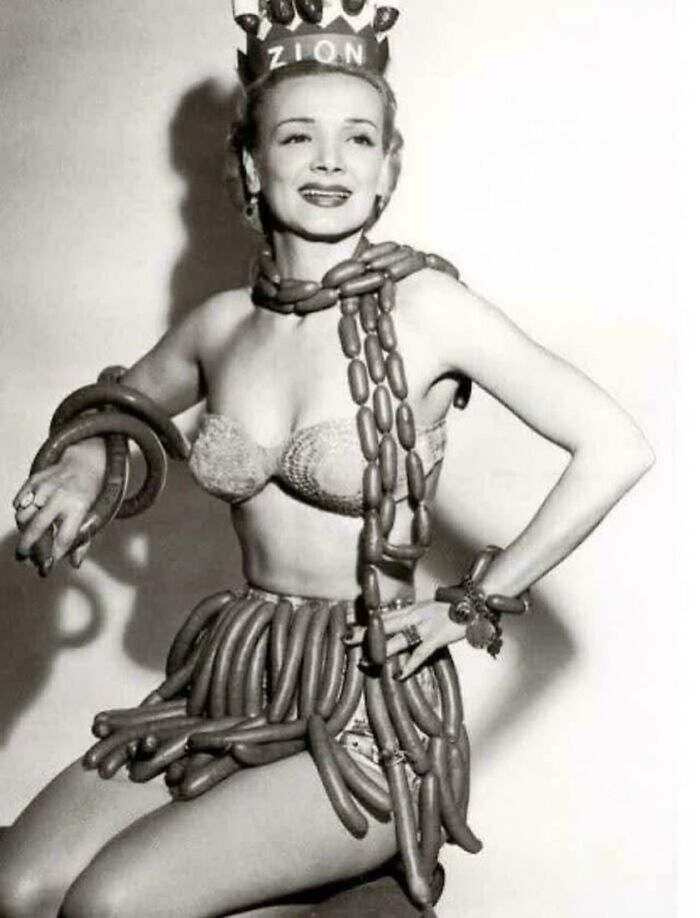
Image source: historycoolkids
#41
In 1908, Dr. Julius Neubronner, a German apothecary and inventor, devised an inventive method of aerial photography by strapping tiny, lightweight cameras onto pigeons.
His “pigeon camera” used a small harness and a clockwork timer that automatically triggered the shutter as the bird flew over towns, landscapes, or military areas. Neubronner originally used pigeons for delivering prescriptions, so adapting them for reconnaissance and photography was a natural leap for him.
The resulting images were ghostly, blurred glimpses of rooftops, streets, and open fields, which are considered some of the earliest examples of aerial photography taken without balloons or kites.
Neubronner’s invention fascinated crowds at exhibitions, where he even demonstrated his pigeons in flight. While the idea had potential military applications (and was tested during WWI for scouting), the rapid advancement of aircraft soon overshadowed his feathered fliers.

Image source: historycoolkids
#42
Published in the St. Louis Post-Dispatch, Missouri, October 23, 1908.
I posted the same headline a few weeks back, but this time I found the article, which provides some more details on what happened. However, it still doesn’t say what exactly led to her coma and ultimate demise.
My guess is that the sodium in the pickles is what got her. Consuming too much sodium can quietly strain your body in several ways, especially over the long term. The most immediate effect is an increase in blood pressure, since excess sodium makes the body retain more water, which raises blood volume and forces the heart to work harder to push blood through the vessels. Over time, this added pressure can damage artery walls and contribute to heart disease, stroke, and kidney problems, as the kidneys struggle to keep up with the excess salt.
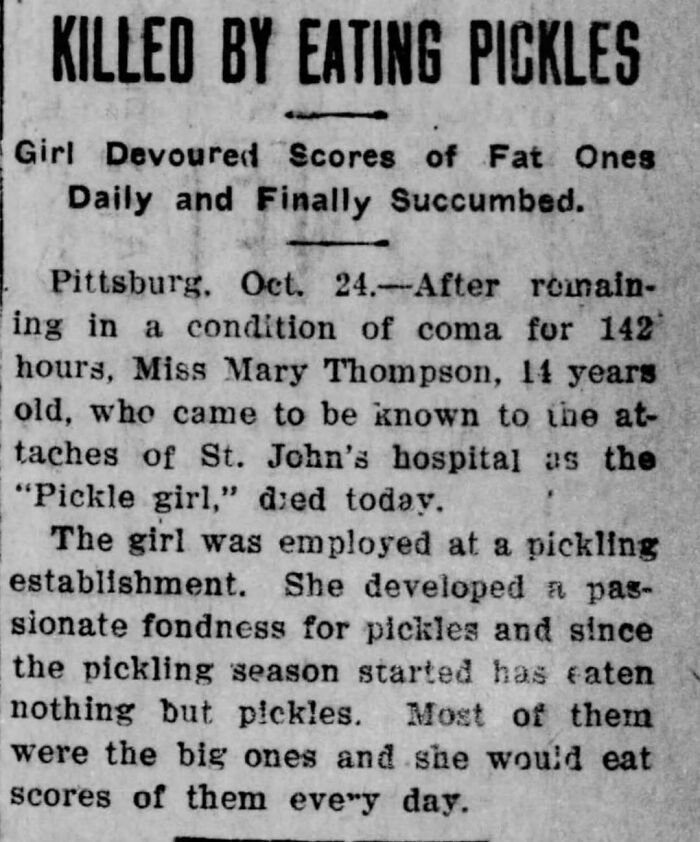
Image source: historycoolkids
#43
Lyndon Johnson listening to a tape from his son-in-law, sent from Vietnam, 1968.
His son-in-law, Captain Charles S. Robb, was serving as a U.S. Marine Corps officer in Vietnam. Robb, who was married to Johnson’s daughter Lynda Bird Johnson, frequently sent tapes home as a way to keep in touch with his family while deployed in a deeply unpopular and brutal war that weighed heavily on the president’s conscience.
Johnson, who had escalated U.S. involvement in Vietnam, often listened to these tapes privately in the White House, a stark personal reminder that the war was not an abstract policy but something that affected his own family.
This moment is sometimes cited to illustrate Johnson’s deep conflict and growing anguish during the final year of his presidency, when mounting casualties, domestic unrest, and his own family’s vulnerability converged, pushing him to announce just weeks later that he would not seek re-election.
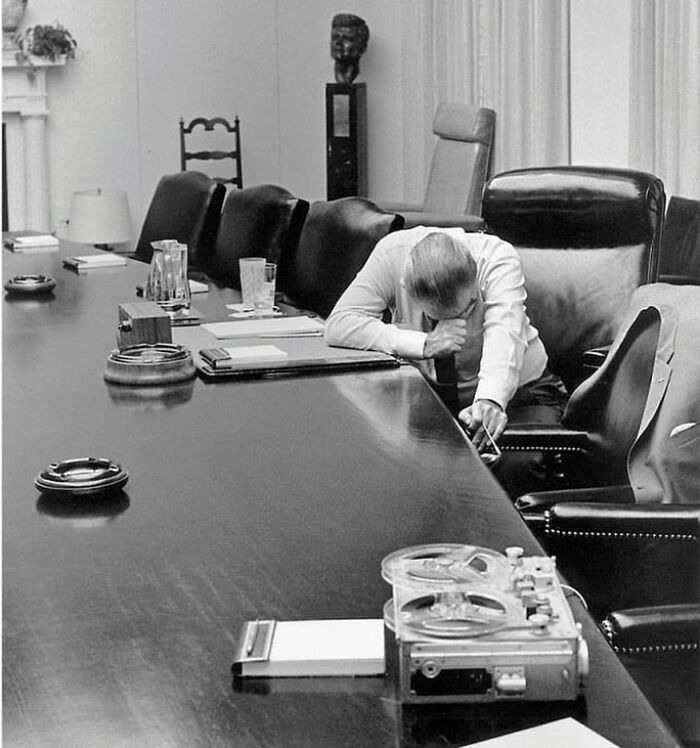
Image source: historycoolkids
#44
This is Rube Waddell, an American baseball player (from the early 1900s) whose life story bewilders me to no end.
In the middle of a game, Waddell would disappear to chase fire trucks. He was easily distracted, so opposing fans would bring puppies, which would have Waddell running over to play with them.
American sportswriter and baseball historian Lee Allen wrote that in 1903, Waddell was “sleeping in a firehouse at Camden, New Jersey, and ended it tending bar in a saloon in Wheeling, West Virginia. In between those events, he won 22 games for the Philadelphia Athletics, […] toured the nation in a melodrama called The Stain of Guilt, courted, married, and became separated from May Wynne Skinner of Lynn, Massachusetts, saved a woman from drowning, accidentally shot a friend through the hand, and was bitten by a lion.”
It should be noted that Waddell was incapable of memorizing his lines for his part in The Stain of Guilt, so he was allowed to improvise his lines in every show. The play went on to critical acclaim.
In 1905, Waddell shared a room with baseball catcher Ossee Schreckengost who refused to continue sharing the room unless there was a clause in Waddell’s contract that forbade him from eating crackers in bed. It should be noted that it was common for players to share the same bed in hotel rooms while on the road. That same year, Waddell missed the World Series after injuring his shoulder while trying to destroy a straw hat.
However, he went on to win a Triple Crown in pitching. If the Cy Young award had existed during this time, Waddell would have won it over Cy Young himself.
He died of tuberculosis at the age of 37 on April Fool’s Day, 1914.
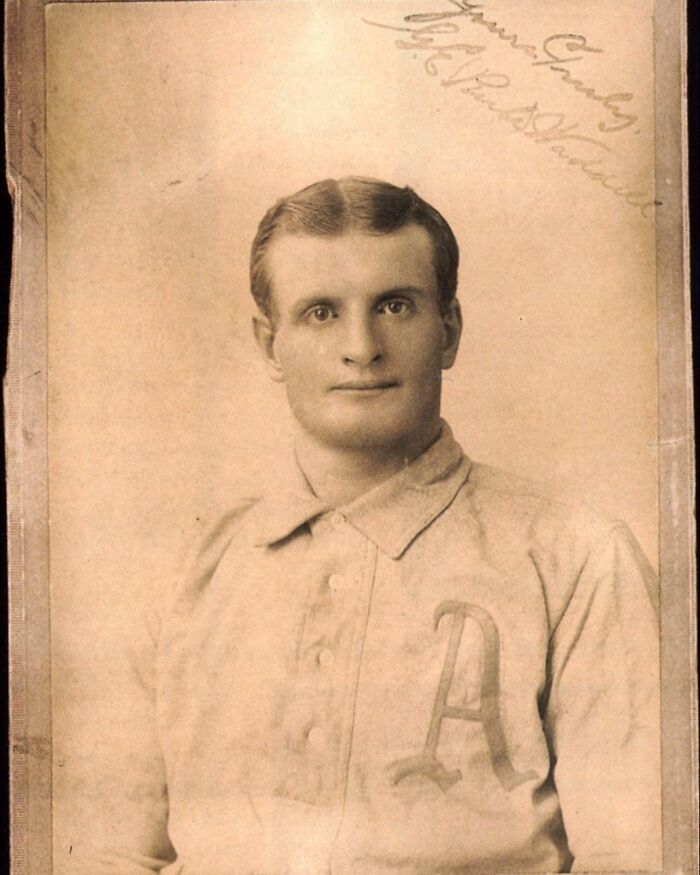
Image source: historycoolkids
#45
Fairchild K-17 camera used for aerial photos during World War 2.
While these cameras were mostly mounted securely in aircraft for steady, automated shooting, they were also designed to allow limited “hand-held” operation when needed, although the term “hand-held” was a bit optimistic given their sheer size and weight.
These cameras could be fitted with a pair of side handles and an optical viewfinder so an aerial photographer could maneuver them to capture oblique angles or quick shots through open hatches or windows. But this was no casual task. With a full 200-foot roll of film loaded in the A-5 magazine, the film magazine alone weighed about 30 pounds. Add the main camera body, a 12-inch lens cone, and all its fittings, and the K-17 tipped the scales at around 55 pounds (25 kg). Swapping in a longer 24-inch lens for higher-altitude detail shots pushed the weight up to nearly 75 pounds (34 kg).
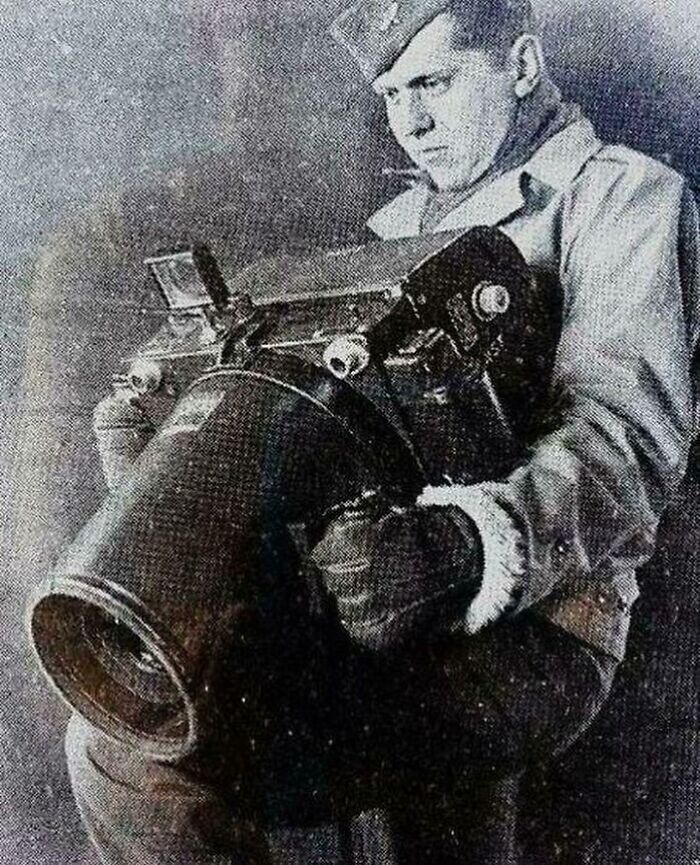
Image source: historycoolkids
#46
Grover Krantz, an American anthropologist best known for his research on human evolution (and his outspoken interest in Bigfoot) made an unusual request for his remains.
When he passed away in 2002, he donated his body to science on the condition that his beloved Irish Wolfhounds would be kept close to him even in the afterlife, just as they were in life.
Today, Krantz’s skeleton, along with the articulated skeleton of his favorite dog Clyde, are preserved and displayed together at the Smithsonian’s National Museum of Natural History.
It should be noted that Clyde passed away long before Dr. Krantz and his bones were saved. I do feel bad for his subsequent dogs, but what you going to do.
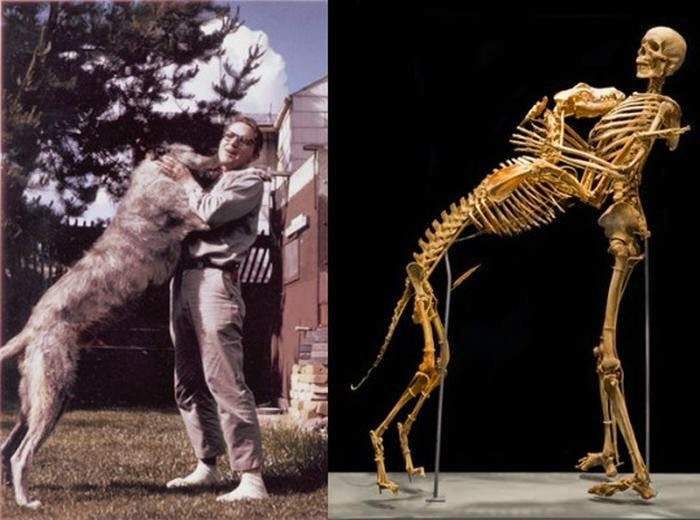
Image source: historycoolkids
#47
Map of all the sunken Japanese ships during World War II.
Japan lost an enormous number of ships—both military and merchant. While precise counts vary by source, historians generally estimate that Japan lost around 2,000 to 3,000 ships in total, including warships and merchant vessels.
For naval ships, the Imperial Japanese Navy lost about 350–400 major warships, including 11 battleships (like Yamato and Musashi), all 6 fleet carriers from the Pearl Harbor attack force (Akagi, Kaga, Soryu, Hiryu, Shokaku, Zuikaku), dozens of heavy and light cruisers, over 120 destroyers, and about 130 submarines.
Merchant marine losses were even higher and more devastating for Japan’s war effort. Estimates place the loss at about 2,000 merchant ships, totaling roughly 8 to 10 million gross tons sunk, mostly by relentless US submarine campaigns and air attacks that crippled Japan’s ability to transport vital supplies and reinforcements across its vast Pacific empire.
By war’s end, Japan’s navy was virtually annihilated as an effective fighting force, and its shattered merchant fleet left the nation starved of resources, which was a decisive factor in Japan’s defeat.

Image source: historycoolkids
#48
Soviet-era phenotype chart used by police to identify different ethnicities in the 1960s.
While the Soviet Union officially rejected racism and emphasized internationalism, the internal passport still required a nationality entry—a category that codified ethnic identity in an administrative sense. This entry didn’t necessarily align with a person’s place of birth or residence, but instead with the nationality listed for the parents, most often the father’s if there was disagreement.
Such facial phenotype cards were part of a wider Soviet practice that blended physical anthropology, criminology, and state surveillance. They were rooted in older pseudoscientific traditions of “anthropometry” and typology, which ironically mirrored similar racial classification efforts in Europe and the United States that Soviet ideology publicly condemned.
By the late Soviet period, this bureaucratic fixation on nationality shaped education quotas to employment to migration restrictions. Despite the USSR’s stated ideal of equality among nations, these classifications often reinforced stereotypes and hierarchies, subtly sustaining forms of ethnic profiling and discrimination.
It’s a stark reminder that even a state that outwardly rejected “race” could still practice its own brand of racialization, encoded in paper trails, passports, and, in this case, an official chart of so-called “typical faces.”
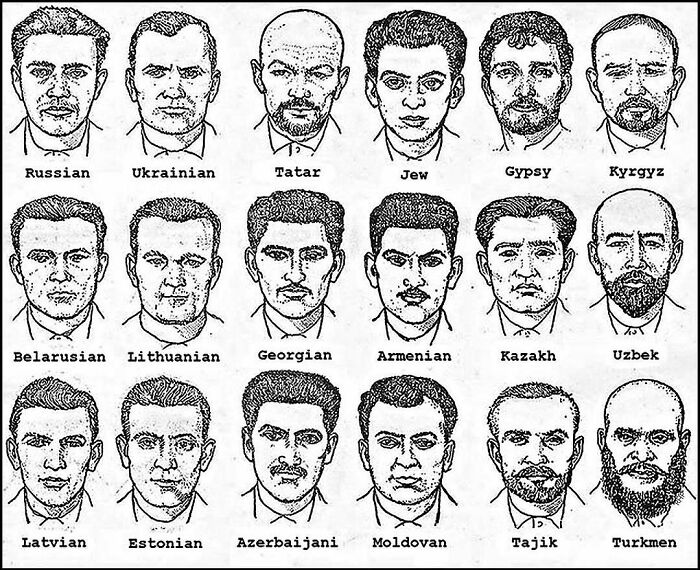
Image source: historycoolkids
#49
French explorer Jean Nicolet (1598–1642) thought he landed in China, so he donned a bright Chinese robe and began firing in the air to establish his authority.
He soon realized that he was in Green Bay, Wisconsin.

Image source: historycoolkids
#50
Jan van Eyck’s “Arnolfini Portrait”, painted in 1434, is one of the most mysterious and technically astonishing works in Western art history.
At the center of its fascination is the tiny convex mirror on the back wall (only about three inches wide) yet it reflects the entire room in stunning detail. In the mirror’s surface, we see not only the backs of the man and woman, but also two additional figures standing in the doorway, one of whom may be van Eyck himself. The clarity of this miniature reflection showcases van Eyck’s unmatched skill with oil paint and his deep understanding of perspective and light.
The man in the painting is believed to be Giovanni di Nicolao di Arnolfini, a wealthy Italian merchant living in Bruges. The woman beside him may be his wife, though scholars continue to debate whether the scene depicts a marriage, a betrothal, or even a memorial. Every object in the room (the dog, the oranges, the bed, the lit candle) has been interpreted as symbolic, though van Eyck gives no clear explanation.
Adding to the mystery is van Eyck’s signature written above the mirror:
“Johannes de eyck fuit hic 1434” (which translates to “Jan van Eyck was here, 1434”)—as if he were a legal witness to the event. Whether this was an actual documentation of a ceremony or some mysterious artistic statement remains unknown.
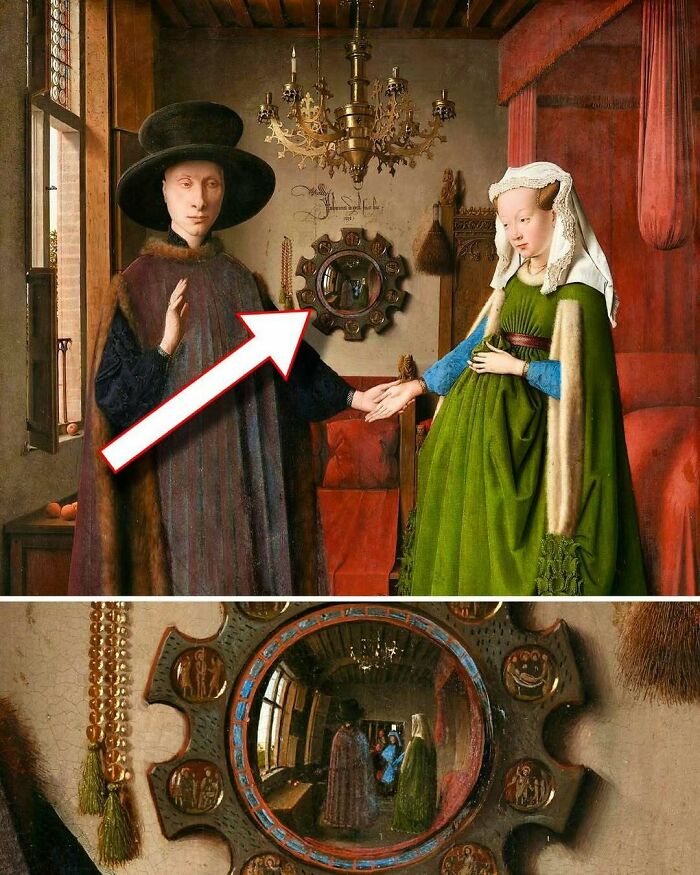
Image source: historycoolkids
#51
Welsh spiritualist Colin Evans feigns levitation by jumping up and down in total darkness and filming himself with an infrared camera in London, 1939.
His trick was surprisingly simple yet effective: Evans would jump into the air in total darkness and use a hidden camera with a flash or infrared trigger to capture himself mid-jump. The resulting photograph would show him suspended above his chair or the floor, apparently defying gravity. To his audiences who were unfamiliar with fast photography and eager to believe in the supernatural, these images appeared to prove he could levitate through psychic power.
Skeptics, however, quickly pointed out the obvious: there were no witnesses who actually saw him “hover” for any length of time, only the staged photos taken at the peak of his jump. Evans’s performances became an example of how easily people’s desire to believe in the paranormal could be manipulated with simple tricks, darkness, and early photographic technology.
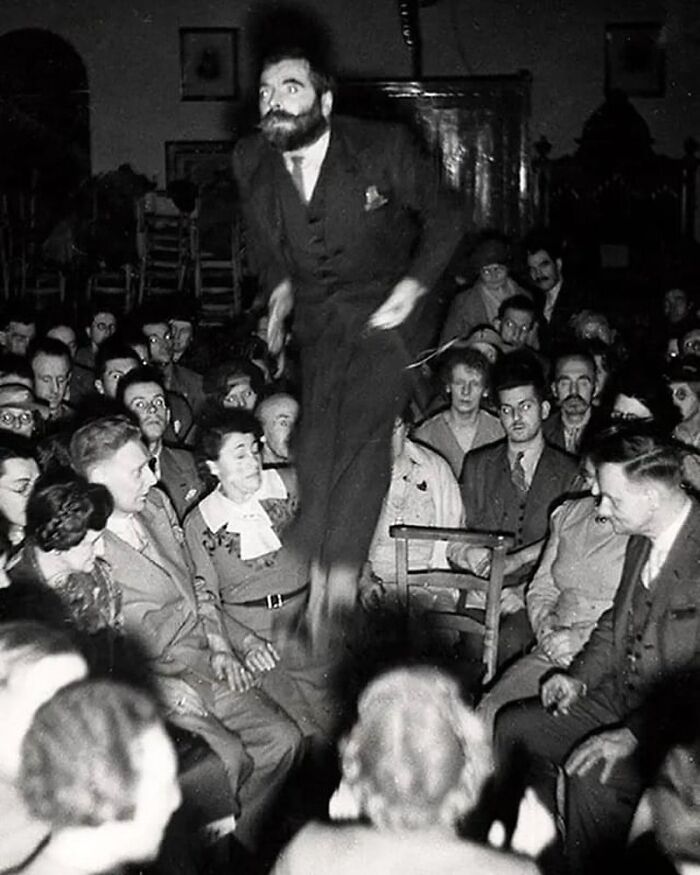
Image source: historycoolkids
#52
On April 28, 1988, Aloha Airlines Flight 243, a Boeing 737-200, suffered a sudden and violent explosive decompression while cruising at 24,000 feet between Hilo and Honolulu.
A large section of the fuselage roof and side walls near the front of the cabin was torn away, leaving the flight deck exposed to open sky. Despite the catastrophic structural failure, the pilots managed to safely land the aircraft at Kahului Airport.
Tragically, the incident claimed the life of a flight attendant who was pulled from the aircraft when the fuselage tore open. She had been standing near the front of the cabin conducting routine duties. Her body was never recovered.
Incredibly, all 89 passengers and remaining crew members survived. Many suffered injuries from debris, wind blast, and turbulence, but the fact that the plane did not break apart completely in flight was credited to skilled flying and a bit of luck.
The incident was caused by metal fatigue in the aircraft’s fuselage, which was worsened by the aircraft’s high number of pressurization cycles (over 89,000 takeoffs and landings). It led to sweeping changes in aircraft maintenance regulations, especially for aging aircraft operating in humid, salt-heavy climates like that of Hawaii.

Image source: historycoolkids
#53
The shaman of Bad Dürrenberg are the remains of a 25-35 year old woman, who was burried 8,600 to 9,000 year ago in Germany.
What makes this burial so extraordinary is the elaborate grave goods and the striking head dress placed around her. The head dress was made from an intricate combination of animal parts, including bones and teeth from deer, wild boar, crane, and pieces of turtle shell.
This rich mix of materials strongly suggests that she held a special role in her community, most likely as a spiritual figure, a shaman or healer, who connected people with the spirit world.
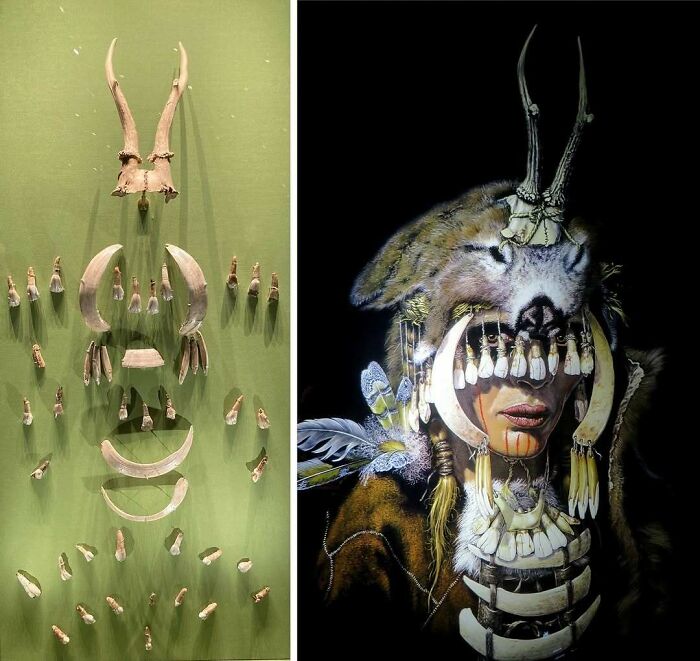
Image source: historycoolkids
#54
Flattening hills to build Seattle, 1905-1930.
Between 1905 and 1930, Seattle began flattening its natural hills to make the city more accessible and buildable. Known as the Seattle regrades, these efforts moved entire sections of the city’s landscape.
The most well known was the Denny Regrade, named after Arthur A Denny, one of the city’s founders. Early Seattle was built on steep and uneven terrain that made travel and development difficult. City leaders, hoping to prepare for growth and investment, decided to level the land using water cannons, steam shovels, and massive sluicing systems.
High pressure hoses blasted away entire hillsides, washing tons of earth into Elliott Bay and nearby low areas. Denny Hill alone was lowered by over 100 feet. The soil removed during these operations was used to fill wetlands and expand the shoreline, creating new land for industry and roads.
Though disruptive and controversial at the time, the regrades completely changed Seattle’s geography and allowed for the modern layout of the downtown core. While a few pieces of the original terrain remain, most of the hills that once shaped the city’s identity were washed away in the name of progress.
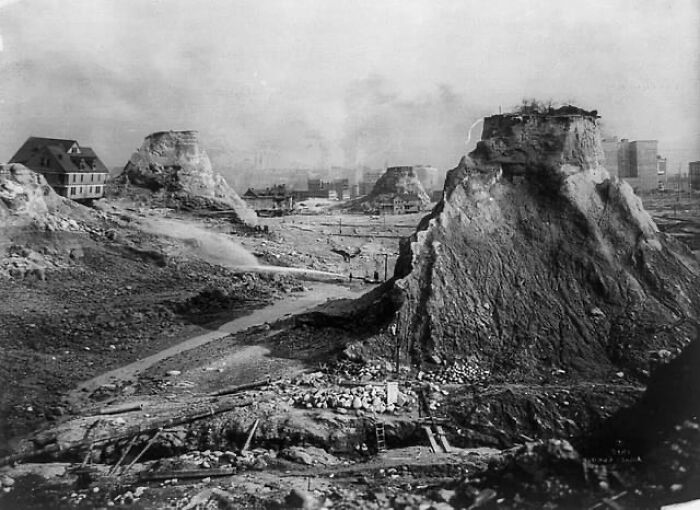
Image source: historycoolkids
#55
Published in The Salina Daily Union, Kansas, June 19, 1908.
At that time, Kansas farmers regularly faced waves of locusts, grasshoppers, or other pests that could destroy wheat and corn fields overnight. On top of that, drought, blight, or hailstorms could wipe out the year’s work in a single afternoon. Articles like this would warn readers about sightings of insect swarms or new plant diseases, calling them a “crop of horrors” because of the potential ruin they brought to already fragile rural economies.

Image source: historycoolkids
#56
In 1940, Mexican photojournalist Enrique Díaz took this photo at the San Juan de los Lagos Fair in Jalisco, Mexico.
It shows a female penitent enacting an extreme form of auto-flagellation or voto (votive penance). Her crown of thorns directly references Christ’s Passion, while the veil suggests humility and anonymity before God. The nopal (cactus pad) embedded in her chest symbolizes both pain and sacrifice. Nopales have long been a powerful symbol of Mexican identity and suffering.
The pelt dish, catching blood from her wounds as she walks, connects this act to a living tradition of offering physical suffering to atone for sins or fulfill a manda (promise) to a saint or the Virgin Mary in exchange for a miracle granted.
San Juan de los Lagos is home to the Virgin of San Juan de los Lagos, one of Mexico’s most venerated figures, drawing pilgrims who perform such dramatic acts of penance.
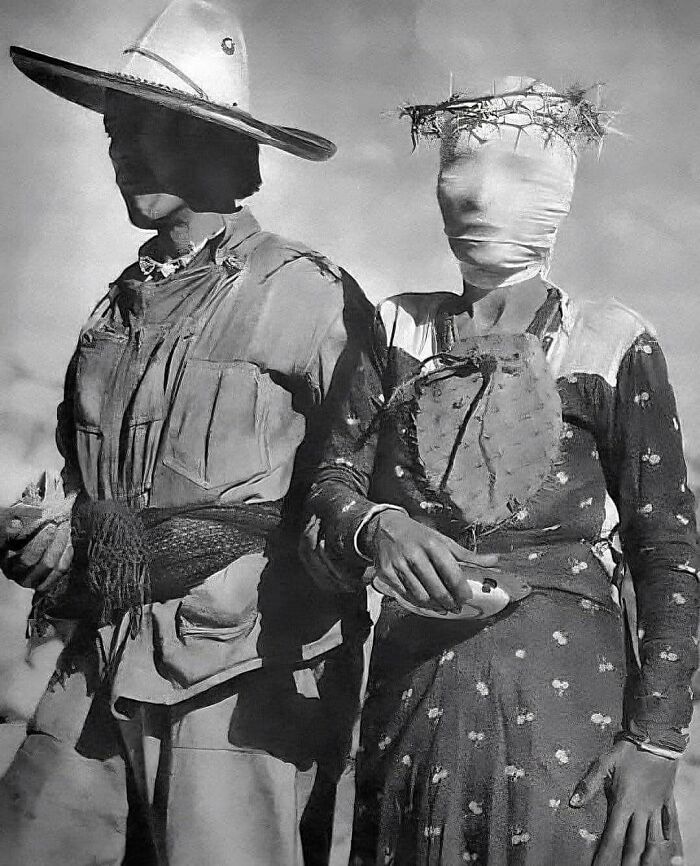
Image source: historycoolkids
#57
A ham radio operator in 1963 using a Teletype Model 15 paired with a Morse key.
The Teletype Model 15, first introduced in the 1930s, was a rugged and reliable electromechanical typewriter that could send and receive text over radio waves using radioteletype (RTTY). It clattered out messages on rolls of paper, translating electrical signals into printed characters with rhythmic precision.
Paired with a traditional Morse key, the setup gave operators the flexibility to communicate via both RTTY and CW (continuous wave) modes. Morse code was still widely used for its simplicity and effectiveness under weak signal conditions, while RTTY allowed for faster, typewritten messages.
As for why she is scantily clad, I believe the room was very hot because of the heat generated from the machines.

Image source: historycoolkids
#58
A rare photograph of a Jewish woman from the Bnei Chorath tribe in what is now Saudi Arabia wearing traditional vestment and burgah from 1929.
The Bnei Chorath (sometimes spelled Banu Qurayza or Bnei Chorath) are traditionally understood to be one of the historic Jewish tribes that lived in the Arabian Peninsula, especially around Medina (Yathrib) before and during the early Islamic period. By the 20th century, very few distinct Jewish communities remained in what is now Saudi Arabia due to centuries of migration, conversion, or expulsion.
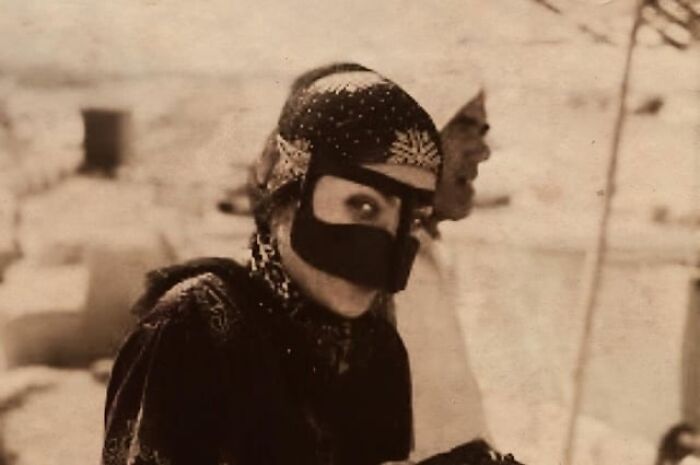
Image source: historycoolkids
#59
John McCain being captured by Vietnamese civilians, Hanoi, 1967.
I was going to give more context to the photo, but David Foster Wallace does a much better job:
“You probably already know what happened. In October of ’67 McCain was himself still a Young Voter and flying his 23rd Vietnam combat mission and his A-4 Skyhawk plane got shot down over Hanoi and he had to eject, which basically means setting off an explosive charge that blows your seat out of the plane, which ejection broke both McCain’s arms and one leg and gave him a concussion and he started falling out of the skies right over Hanoi. Try to imagine for a second how much this would hurt and how scared you’d be, three limbs broken and falling toward the enemy capital you just tried to bomb. His chute opened late and he landed hard in a little lake in a park right in the middle of downtown Hanoi, Imagine treading water with broken arms and trying to pull the life vest’s toggle with your teeth as a crowd of Vietnamese men swim out toward you (there’s film of this, somebody had a home – movie camera, and the N.V. government released it, though it’s grainy and McCain’s face is hard to see). The crowd pulled him out and then just about k**led him. U.S. bomber pilots were especially hated, for obvious reasons. McCain got bayoneted in the groin; a soldier broke his shoulder apart with a rifle butt. Plus by this time his right knee was bent 90-degrees to the side with the bone sticking out. Try to imagine this. He finally got tossed on a jeep and taken five blocks to the infamous Hoa Lo prison – a.k.a. the ‘Hanoi Hilton,’ of much movie fame – where they made him beg a week for a doctor and finally set a couple of the fractures without anesthetic and let two other fractures and the groin wound (imagine: groin wound) stay like they were.”
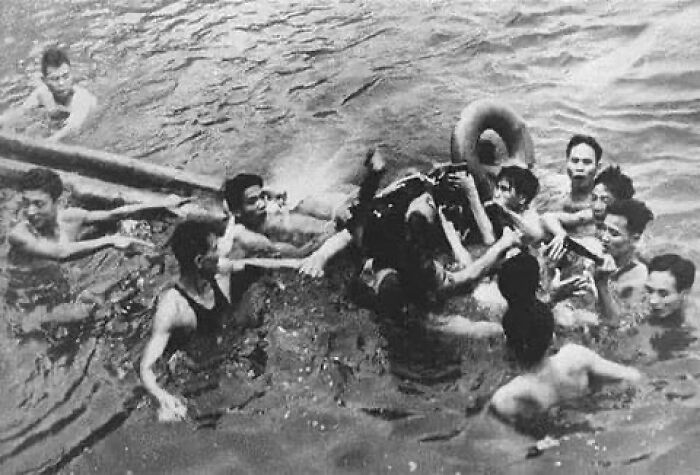
Image source: historycoolkids
#60
A woman from Hiroshima showing her back where her skin is burned in a pattern of the kimono worn at the time of the explosion, 1945.
When the intense flash of thermal radiation struck the city, it seared exposed skin instantly, but the thin fabric of clothing sometimes offered slight protection, leaving ghostly outlines of floral or geometric patterns on survivors’ bodies. Dark dyes often absorbed more heat, causing deeper burns where the fabric was darkest, while lighter areas reflected some of the rays.

Image source: historycoolkids
#61
Robin Williams cheerleading for the Denver Broncos, November 11, 1979.
The Denver Broncos secured a dominant 45–10 win over the New England Patriots, but it was Robin Williams’ appearance as Mork from Ork that stole the spotlight.
In a spirited halftime stunt tied to his hit TV show Mork & Mindy, Williams became the NFL’s first male cheerleader, dressed in full Broncos cheer attire. His outfit included white knee-high cowboy boots, a sequined mini skirt and top, an orange scarf, and gloves, all worn with characteristic flair. Bursting with energy, Williams danced and joked on the sidelines, turning the game into a moment of surreal comedy and pop culture history.

Image source: historycoolkids
#62
A British soldier scolding a German woman who reportedly laughed during a mandatory screening of footage showing the concentration camp conditions.
These screenings were part of a broader Allied policy to force German civilians to confront the reality of the war crimes perpetrated in their name. In this specific case, the woman was removed from the screening after laughing, and then ordered to return and watch the film again.
Her reaction was documented to highlight the range of German civilian responses—shock, denial, indifference, or in rare but disturbing cases, mockery.

Image source: historycoolkids
#63
This is the 1885 photo of the Leatherman, a mysterious itinerant figure who became a local legend in Connecticut and New York during the late 19th century.
He was known for walking a 365-mile circuit through rural towns, completing the loop roughly every 34 days for decades. His clothing was entirely handmade from scraps of leather, including his boots, hat, coat, and pants.
Though he rarely spoke and no one knew his real name, he was widely regarded as harmless and kind, often accepting food from locals but never staying long. His origins remain unknown, though some speculated he was French-speaking and possibly of Canadian or European descent.
When he passed away in 1889, he was buried in Ossining, New York, though even his gravesite was later disturbed during construction.
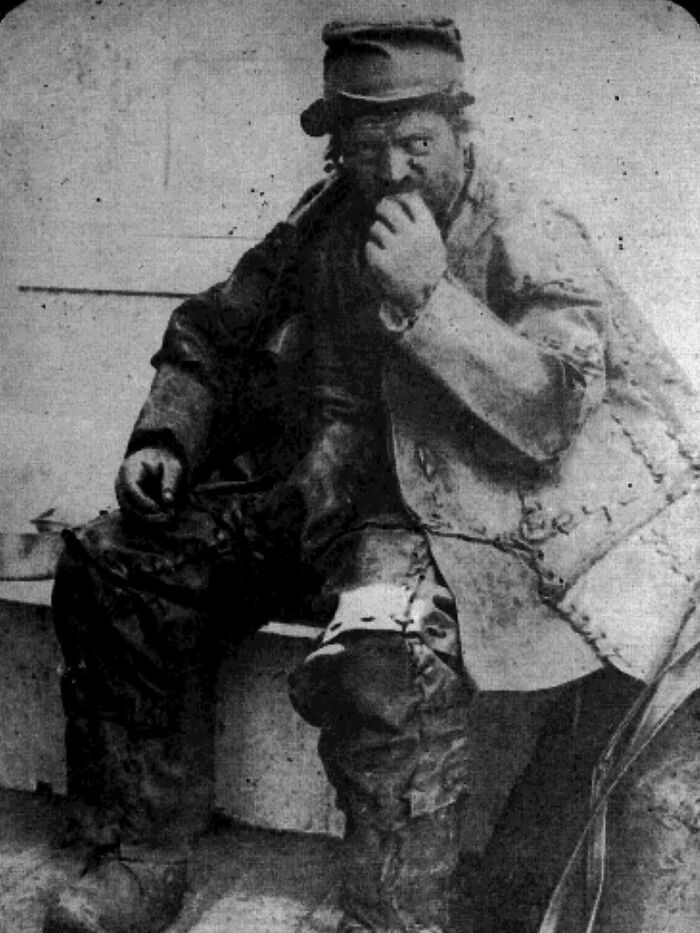
Image source: historycoolkids
#64
Amou Haji, often referred to as the “World’s Dirtiest Man,” was an Iranian hermit who became famous for reportedly not bathing for over 60 years.
He lived in the village of Dejgah in Iran’s southern Fars province and was known for his unconventional lifestyle. He avoided water and soap out of a deep-seated belief that bathing would make him sick. Despite his unhygienic habits, he lived to the remarkable age of 94, smoking animal dung in a pipe, eating roadkill (mostly porcupines), living in a hole he dug, and wearing a soldier’s helmet when it got cold outside. He began to live like this after a breakup led to immense emotional distress.
Ironically, after villagers finally persuaded him to wash for the first time in decades, Amou Haji passed away just a few months later in 2022.
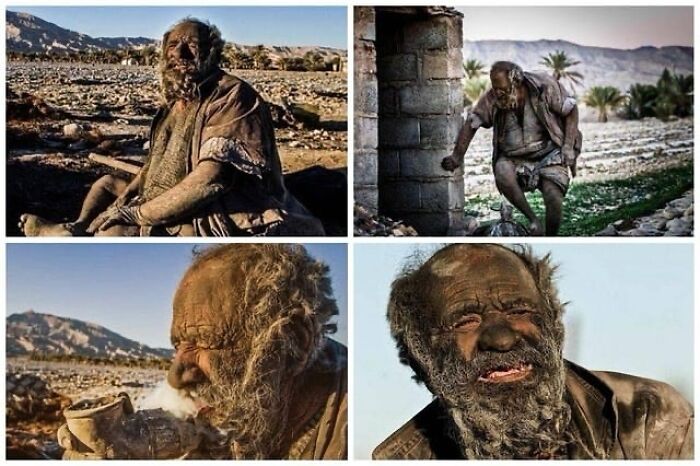
Image source: historycoolkids
#65
Welsh wrestler Adrian Street with his coal miner father, 1974.
Adrian Street, born into a coal mining family in Brynmawr, Wales, rejected the harsh, traditional life of the mines that his father and generations before him had endured. By the 1970s, he had reinvented himself as an androgynous, flamboyant figure in the macho world of British wrestling, known for his peroxide hair, heavy makeup, and feather boas. His persona was designed to provoke and unsettle audiences expecting gritty, working-class brawlers.
In the photo, Street stands in full glittering wrestling regalia next to his father, still in his miner’s gear, covered in coal dust, looking every bit the symbol of the old industrial working class. The contrast is striking: the proud, defiant son gleaming in glam costume beside his stoic, exhausted father, who seems bemused and perhaps a bit bewildered by what his son has become.
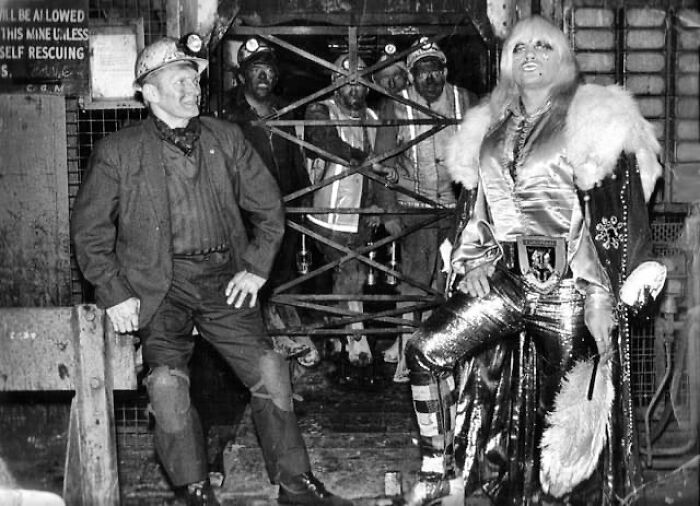
Image source: historycoolkids
#66
A waitress carries a tray with a full-course meal for $1.28 in 1948.
Adjusted for inflation, this meal costs approximately $17.42.

Image source: historycoolkids
#67
Superman poster from 1949.
I wonder how Superman felt about communists though. The Red Scare took place in the United States from the late 1940s to the mid-1950s, driven by fears of communist infiltration during the early Cold War. It intensified after the Soviet Union’s tested nuclear weapons in 1949, China’s turn to communism, and the Korean War.
Government efforts to root out alleged communists led to loyalty oaths, investigations, and blacklists, especially in Hollywood and federal jobs. Senator Joseph McCarthy became the face of the era, accusing people (often without evidence) of communist ties. His aggressive tactics peaked during the televised Army-McCarthy hearings in 1954, after which he was censured by the Senate. The scare faded soon after but left a legacy of fear, political repression, and damaged civil liberties.
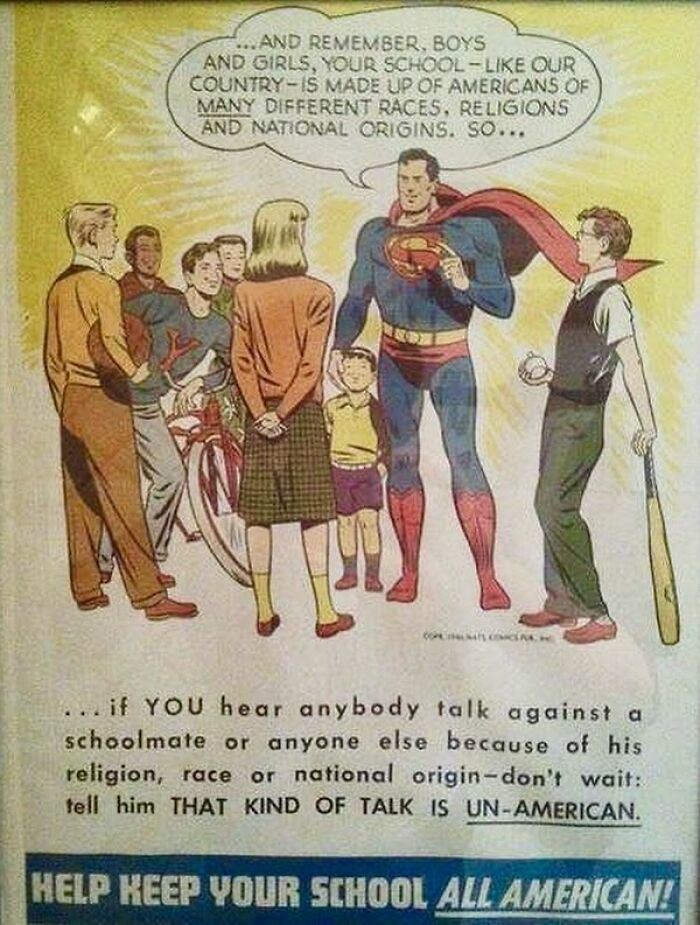
Image source: historycoolkids
#68
French soldier from a small village in Normandy, Georges Roy was wounded at the front, losing both arms and his sight, becoming what the French called a “gueule cassée” (literally, a “broken face”), a term used more broadly for severely disfigured veterans.
Marguerite Lavenue came from the same village but was only an acquaintance before the war. When news of his devastating injuries reached home, she felt moved to do something extraordinary. Rather than see him face a future of isolation and dependency in an era when state support for such wounded veterans was minimal and families often struggled to care for them, she offered to marry him. They wed in Paris in 1917 while the war still raged on the Western Front.
Newspapers at the time covered their wedding as a symbol of sacrifice, devotion, and a different kind of bravery. Marguerite stepping forward to share a life with a man who would forever rely on her for even the simplest tasks. The couple settled down in Normandy after the war. Accounts suggest that Marguerite dedicated herself fully to her husband’s care.
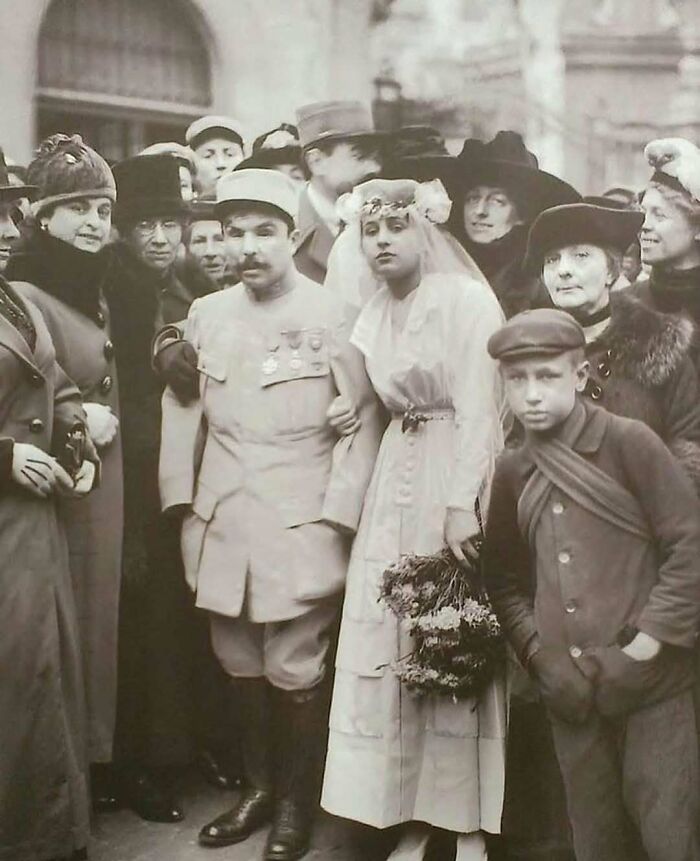
Image source: historycoolkids
#69
Terry Fox was just 18 when he lost his right leg to osteogenic sarcoma, a bone cancer that changed the course of his life, but didn’t break his spirit.
In 1980, with a prosthetic leg and an unshakable will, he set out on the “Marathon of Hope,” aiming to run across Canada to raise both awareness and funds for cancer research. He ran a full marathon (26 miles) every single day for 143 days, covering over 3,300 miles before the return of his cancer forced him to stop just outside Thunder Bay, Ontario. He passed away less than a year later, at only 22.
But his legacy endures. His run galvanized a nation and continues to inspire people around the world. The Terry Fox Run, held annually in dozens of countries, has raised over $850 million for cancer research to date.

Image source: historycoolkids
#70
Italian satirical map of Europe in the 1870s.
There’s a lot to unpack here. A few observations right off the bat:
1. Switzerland being same ole Switzerland.
2. Russia is the big scary boogeyman
3. Norway and Sweden are just chilling and vibing.
4. Finland showing off its bearfit drip.
5. Iceland is holding a fish?
6. Ottoman Empire is overrun by crocodiles wearing hats?
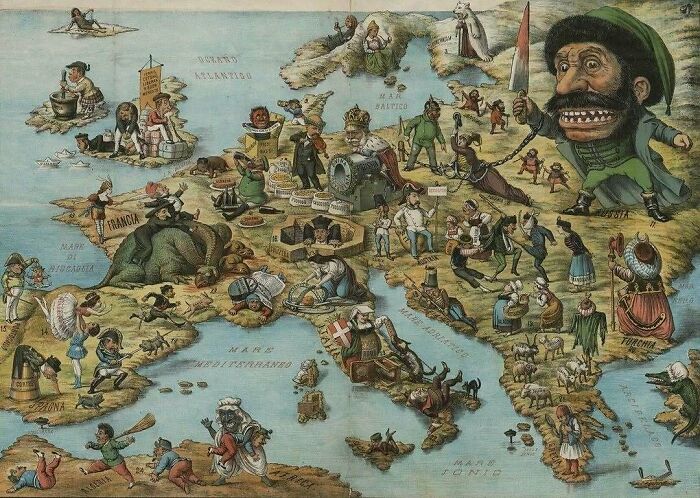
Image source: historycoolkids
#71
A visitor at a gallery recognizes her deceased son in a photograph on the 12th anniversary of the ethnic cleansing in Abkhazia, 2005.
Apparently she didn’t know his fate until that very moment…
For some context, The conflict began in August 1992, when Georgian forces entered Abkhazia to suppress a separatist movement. Fierce fighting broke out between Georgian troops and Abkhaz separatists, who received support from Russian military units and North Caucasian fighters.
As Abkhaz forces advanced, a campaign of forced displacement unfolded. In September 1993, separatist forces captured Sukhumi, Abkhazia’s capital, and large-scale acts of violence were carried out against ethnic Georgian civilians, government officials, and captured soldiers.
By the end of the war, more than 200,000 ethnic Georgians (along with smaller numbers of Greeks, Armenians, and Russians) had been driven from their homes. Entire communities were uprooted, houses and villages destroyed, and families scattered.
International organizations, including the United Nations, have described these events as ethnic cleansing due to the targeted nature of the expulsions based on ethnicity.
Today, Abkhazia remains a self-declared independent region with limited international recognition. Most of the displaced Georgians have never been allowed to return, and the conflict has left deep scars, both politically and emotionally, that continue to shape Georgian-Abkhaz relations and regional stability.
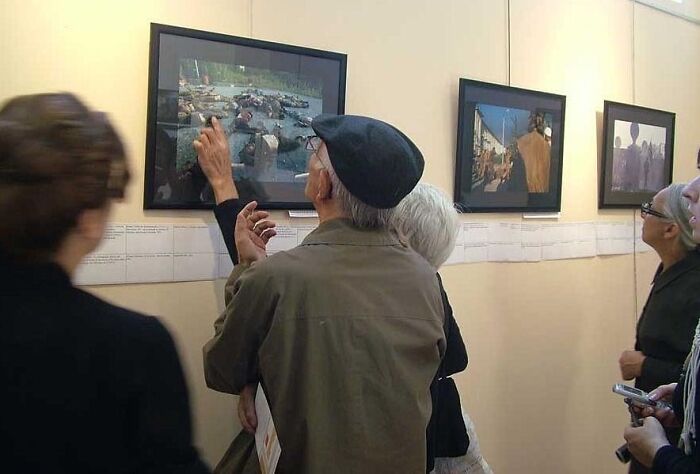
Image source: historycoolkids
#72
A semester at Harvard in 1869 cost $170.42, roughly $4,360 in 2025 dollars, based on long-term average U.S. inflation rates.
A semester at Harvard College for the 2025-2026 academic year will cost $57,328 for tuition alone. Including room and board, health insurance, and other fees, the total cost of attendance is estimated to be $82,950.
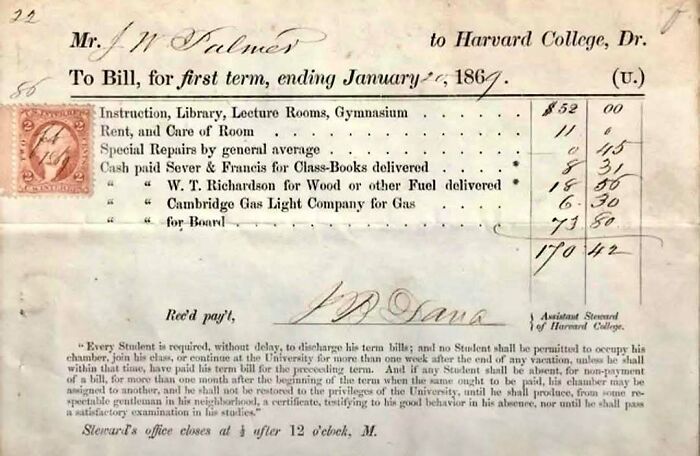
Image source: historycoolkids
#73
In 1952, a group of farmers “arrested” the town’s sheriff when he attempted to evict a family from their farm at the behest of a local insurance company.
The Ziegenhardt brothers—Paul, Chris, and Fred—had spent their whole lives tending crops and minding their own affairs. But that changed when a collapsed insurance company and a clever legal clause claimed their land was no longer theirs.
That’s when Mrs. White entered the picture, snapping up the property for a suspiciously low price. It wasn’t illegal, just the kind of shady deal that hides in contracts and technicalities. She ordered the Ziegenhardts to leave. But the brothers did not give in easily.
Rather than walk away, they built Fort Ziegenhardt.
Using scrap wood, farm tools, and anything else at hand, they transformed their home into a barricaded compound. They created lookout spots from hay bales, stood guard, and relied not on weapons but on sheer willpower. Most importantly, they had the support of their community.
When the sheriff arrived, expecting a routine eviction, he was instead met by a homemade stronghold and a line of determined neighbors. The officials tried reason. The Ziegenhardts didn’t move. They tried force. The locals stood firm. Even when the state police got involved and the governor looked the other way, Fort Ziegenhardt held out.
Eventually, the full weight of the system came crashing down. Arrests were made. One man, Floyd Schreiber, was sentenced to five years for standing up to what he believed was wrong.
The Ziegenhardts eventually lost their land.
Mrs. White got her deed.

Image source: historycoolkids
#74
Portrait of a California gold miner with pick and shovel, sixth-plate daguerreotype, c. 1850.
Fun fact: During the California gold rush of 1849, eggs were $3 each, not adjusted for inflation. When adjusted for inflation, that would be nearly $120 today.
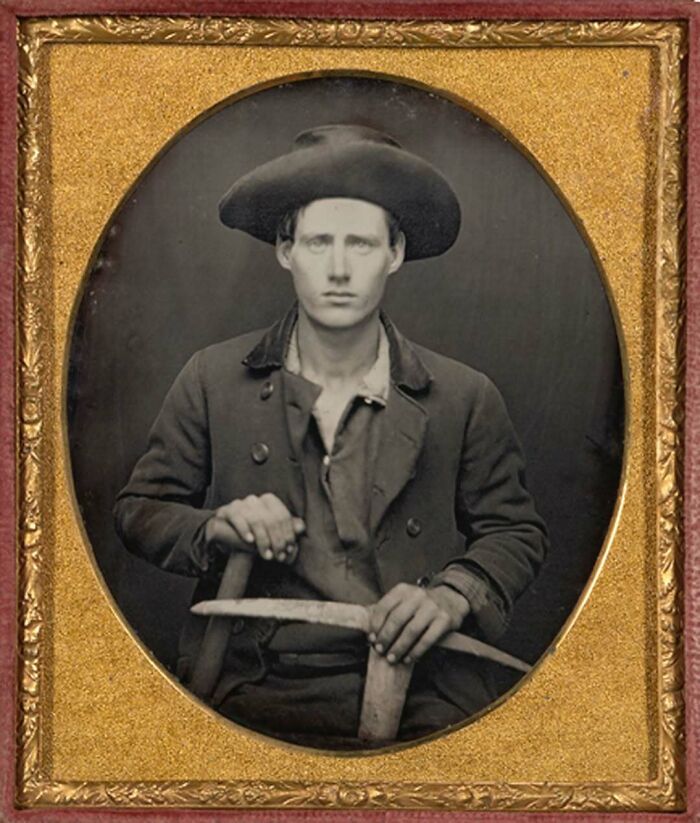
Image source: historycoolkids
#75
In February 1947, the tiny settlement of Snag in Yukon, Canada, recorded what remains the lowest temperature ever measured in North America: -83°F (-63.9°C).
Snag was a remote airstrip village at the time, mostly home to a handful of Indigenous people, fur trappers, and weather station workers. The cold was so intense that it created bizarre and memorable effects. Sound traveled so clearly in the still, dense air that people claimed they could hear voices and dog teams from 4 miles away.
Breath expelled into the air would freeze instantly, turning into a fine powder of ice crystals that drifted to the ground rather than evaporating. The local river ice, under such extreme pressure from the cold, would crack and boom, echoing through the silent forests.
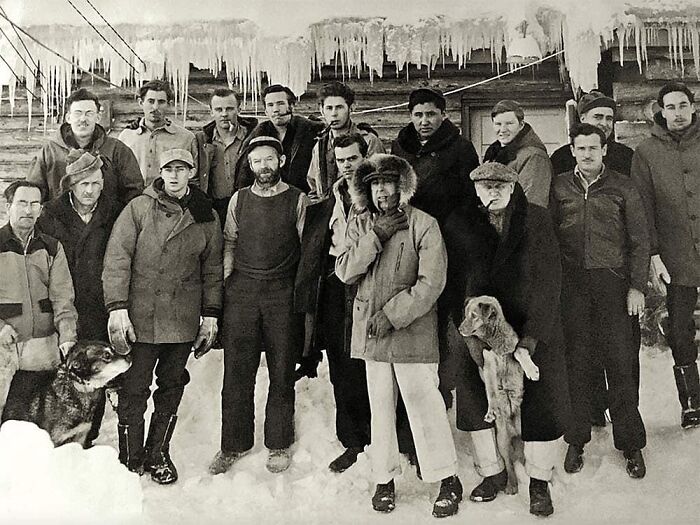
Image source: historycoolkids
#76
Portrait of neck ruff with a woman’s head, The Netherlands, circa 1625. Unknown artist.
Back in the late 16th and early 17th centuries, lace was incredibly labor intensive to make, often crafted by hand over weeks or even months. A large, finely worked ruff made with multiple layers or “double lace” was a clear signal that the wearer had wealth, access to skilled artisans, and the time (and servants) to maintain something so impractical.
In some cases, a single elaborate ruff could cost as much as a small estate. And since they were made of delicate materials and easily damaged, they had to be stored carefully, cleaned with special tools, and starched and set into shape with hot irons—a whole process in itself.
So when you see a portrait of someone wearing a massive, intricate ruff, you are basically looking at them saying, “Look how rich I am. I can afford to wear something this ridiculous just for show.”

Image source: historycoolkids
#77
Fragment of a Seljuk box with a combination lock, which is said to allow for approximately 4 billion possible combinations.
Without the exact sequence, unlocking it would have been nearly impossible.
Dating back to 1200–1201, the Seljuk box exemplifies the advanced metalworking and mechanical sophistication of the Islamic world during the medieval period. Made in Iran, the box is composed of cast and hammered brass, richly inlaid with silver and copper in elegant geometric and calligraphic patterns.
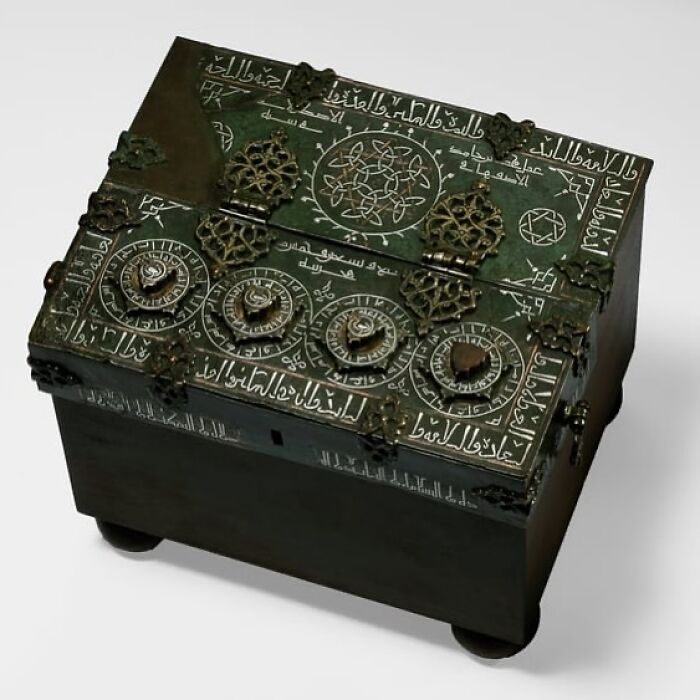
Image source: historycoolkids
#78
This is Lloyd Cupp.
He was serving with the 3rd Armored Division overseas during World War II.
His mom (Dora) wrote to him often, but by September 21st 1944, she had not received a reply in over a month. Still unaware of any change, she wrote him another letter (swipe left) that day.
“Huckabay, Tex Sept. 21, 1944
Darling Son:
It was one month ago son, that you wrote your last letter that we’ve received from you. Maybe others are on the way but I doubt if you’ve had a chance to write anyone. But all our thoughts are there with you wherever you are. Somehow my faith still holds out, that you’ll come through it all and be with us some day and it sure can’t be too soon to suit your mom and the rest of us here at home.
We’re alright. Mrs. Ginace is able to be up most of the time and the babies are fine also. Just received a letter from Ruth. She’s getting on just fine but working hard. Lloyd, the old Flynn’s house is being torn down. So is the Abe Hicks house and the Tom Smiths garage will be wrecked soon.
So some of the old houses are coming down it seems. But they’ll be rebuilt elsewhere. That’s the way life is. It comes and goes. We have one life to live. The great hereafter comes my darling, and I want you to be ready to meet it when it comes as it will come to both you and me some day. Your mom will be waiting for you over there should I go first, as it’s natural I should.
I know you’ve gone through all the torments any one could go through. It’s been plenty hard and then some. More than most of us will ever know. But it’s something we can’t help. Neither you nor I, or the many other boys over there fighting for the liberty of the world.
May God Bless you Son, Always.
From Mother and all.“
What she didn’t know was that Lloyd had lost his life in combat on September 5th, just sixteen days earlier. He was 26 years old. The news had not yet reached her yet. Her letter would eventually be returned to her, marked with the word “Deceased.”
Dora, lived for another two decades. She passed away in 1964 at the age of 81.
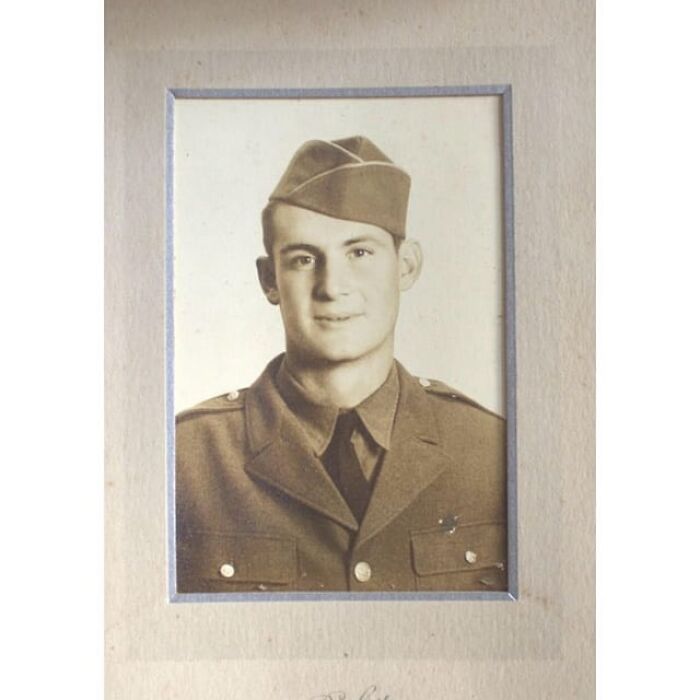
Image source: historycoolkids
#79
In 1936, Isabella Gilbert of Rochester, New York introduced a beauty device called the “Dimple Maker,” designed to create dimples by pressing two knobs into the cheeks.
Worn like a facial clamp, the contraption was meant to be used for five minutes at a time, a few times a day, during ordinary activities such as reading or dressing. Advertisements encouraged users to smile into a mirror while wearing it, promising that regular use would eventually produce lasting dimples.
Despite the enthusiasm behind its marketing, the American Medical Association dismissed the device as ineffective, warning that not only would it fail to produce dimples, but extended use could even pose serious health risks, including cancer.
While the Dimple Maker may have been a questionable invention, it was nonetheless financially successful, earning Gilbert as much as $12,000 (approximately $280k today).
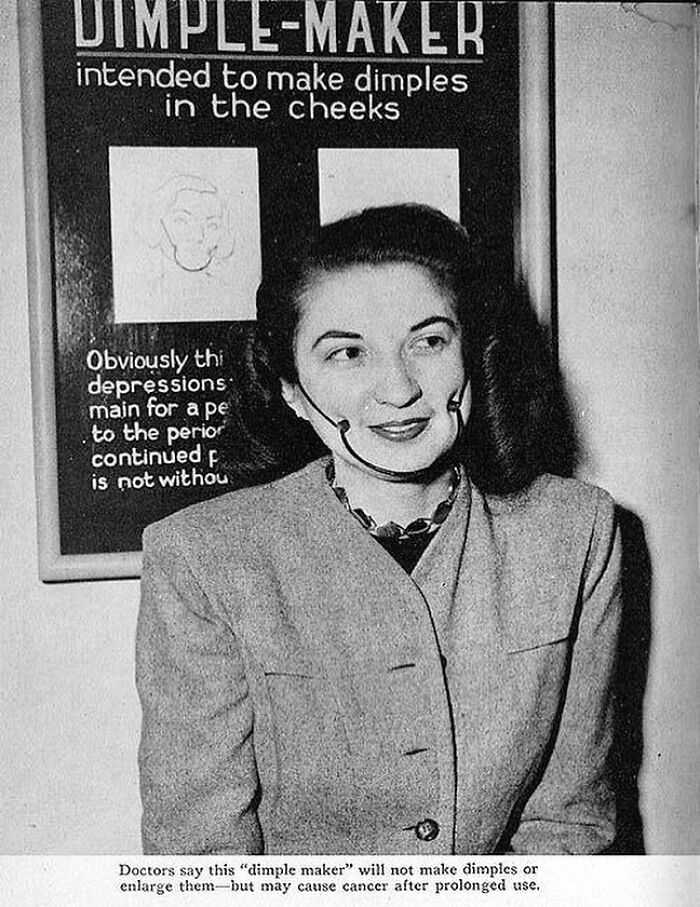
Image source: historycoolkids
 Follow Us
Follow Us




